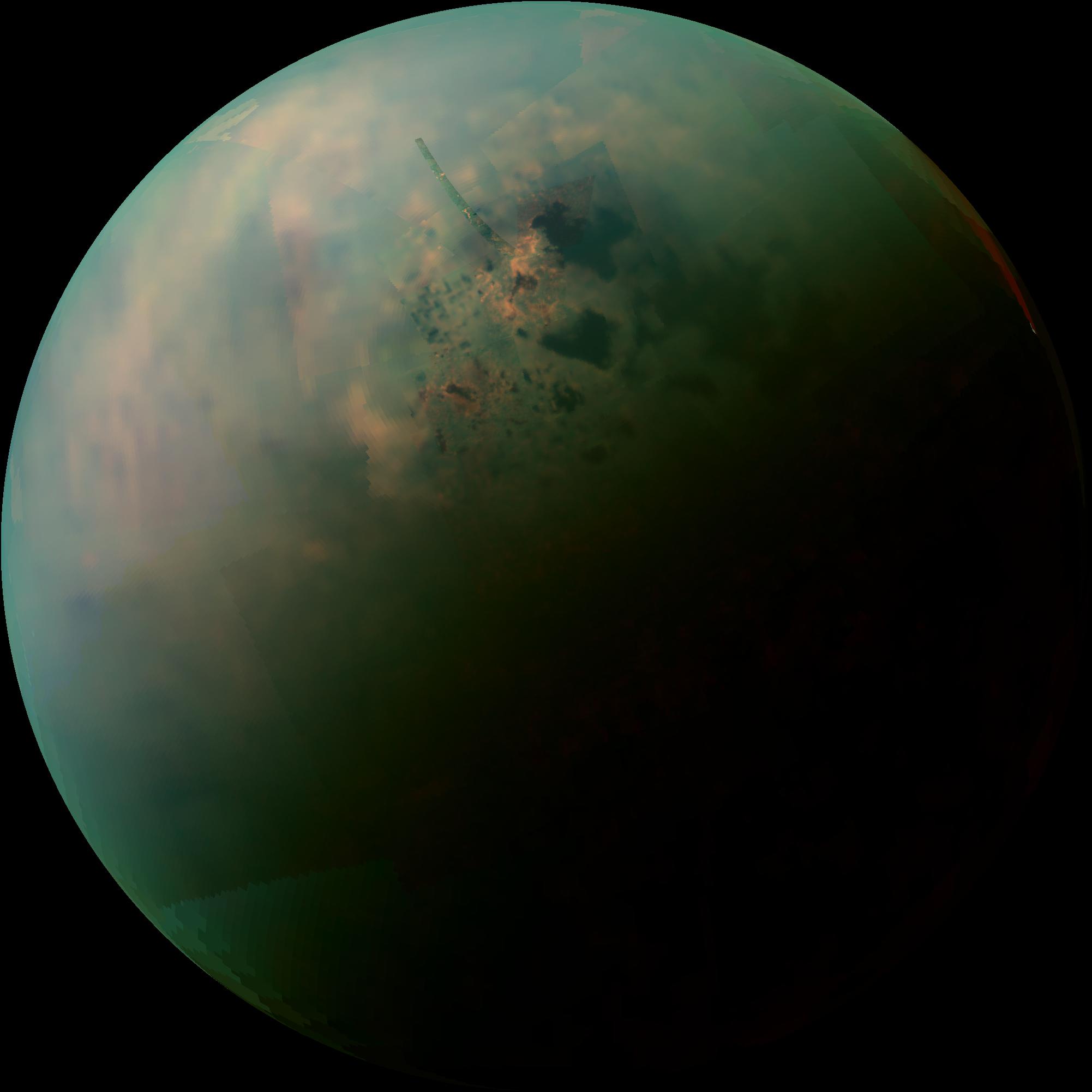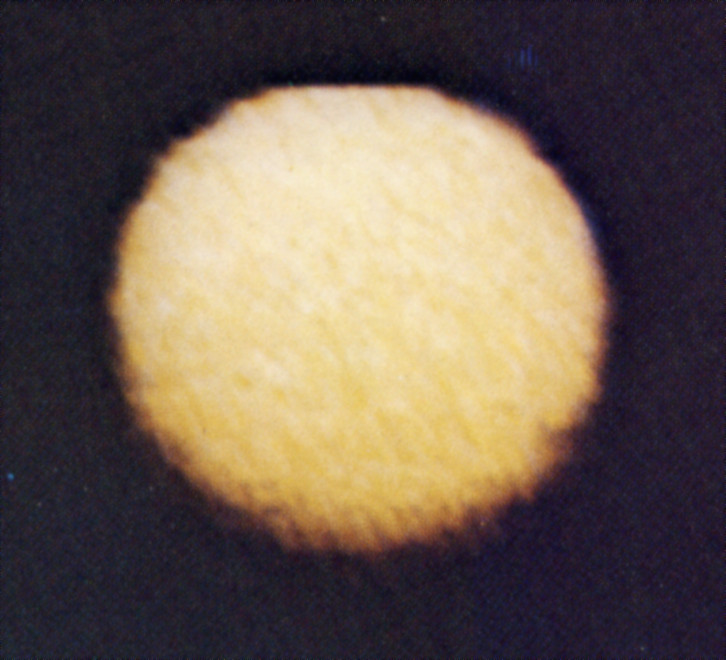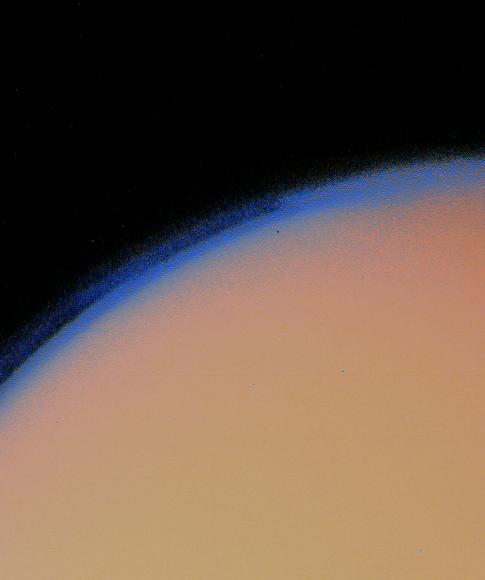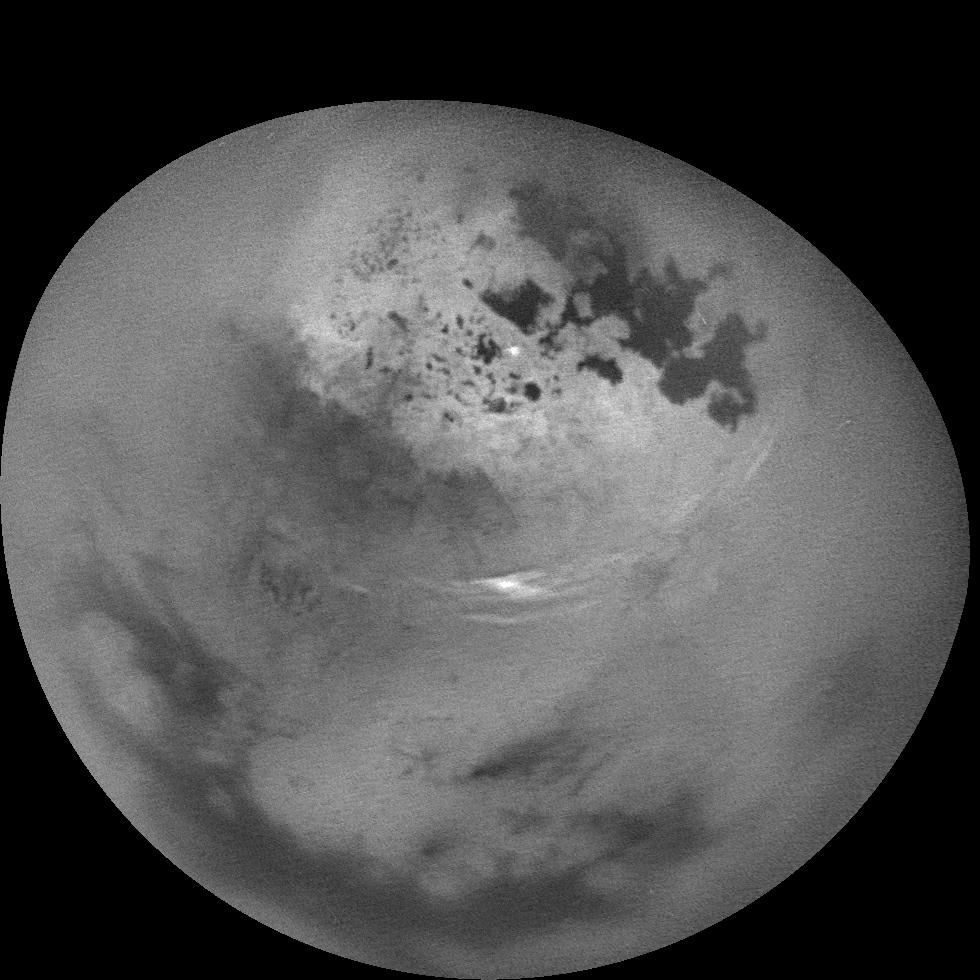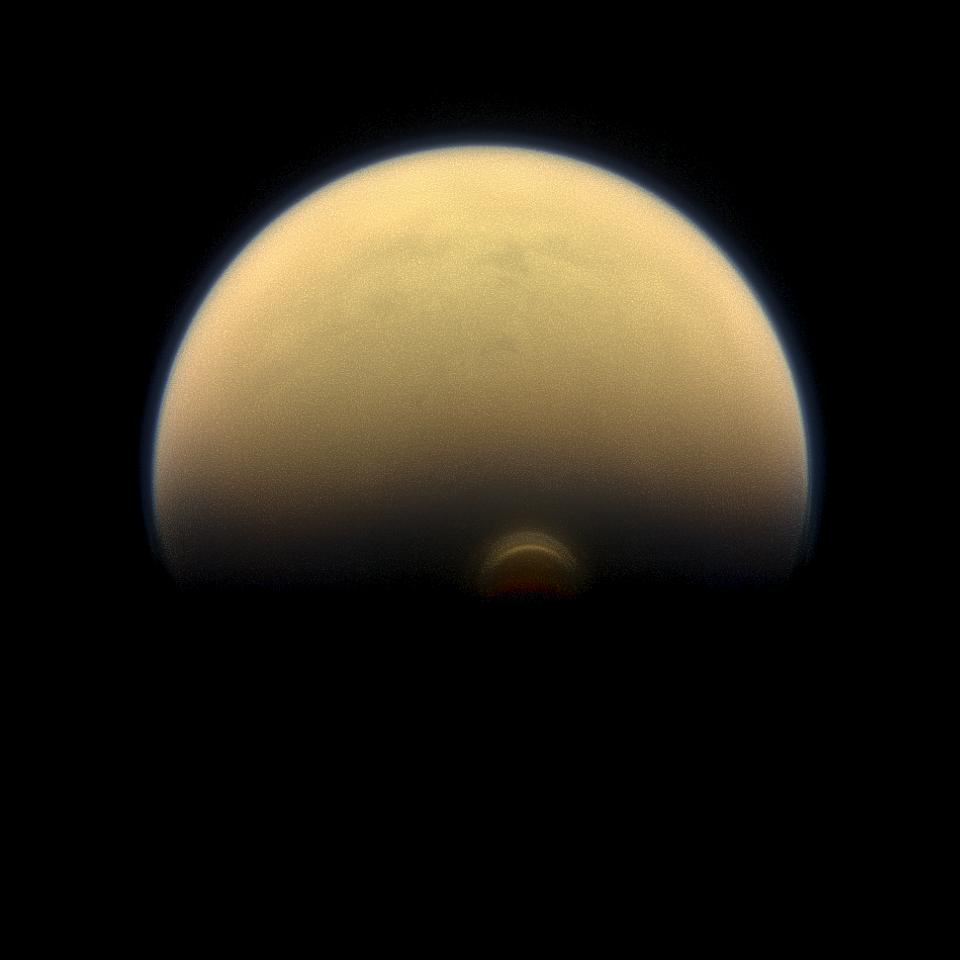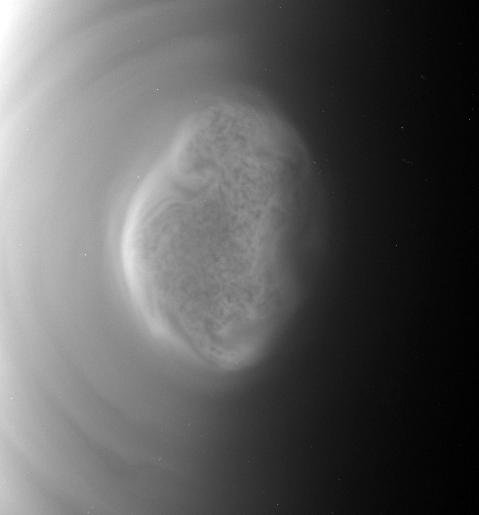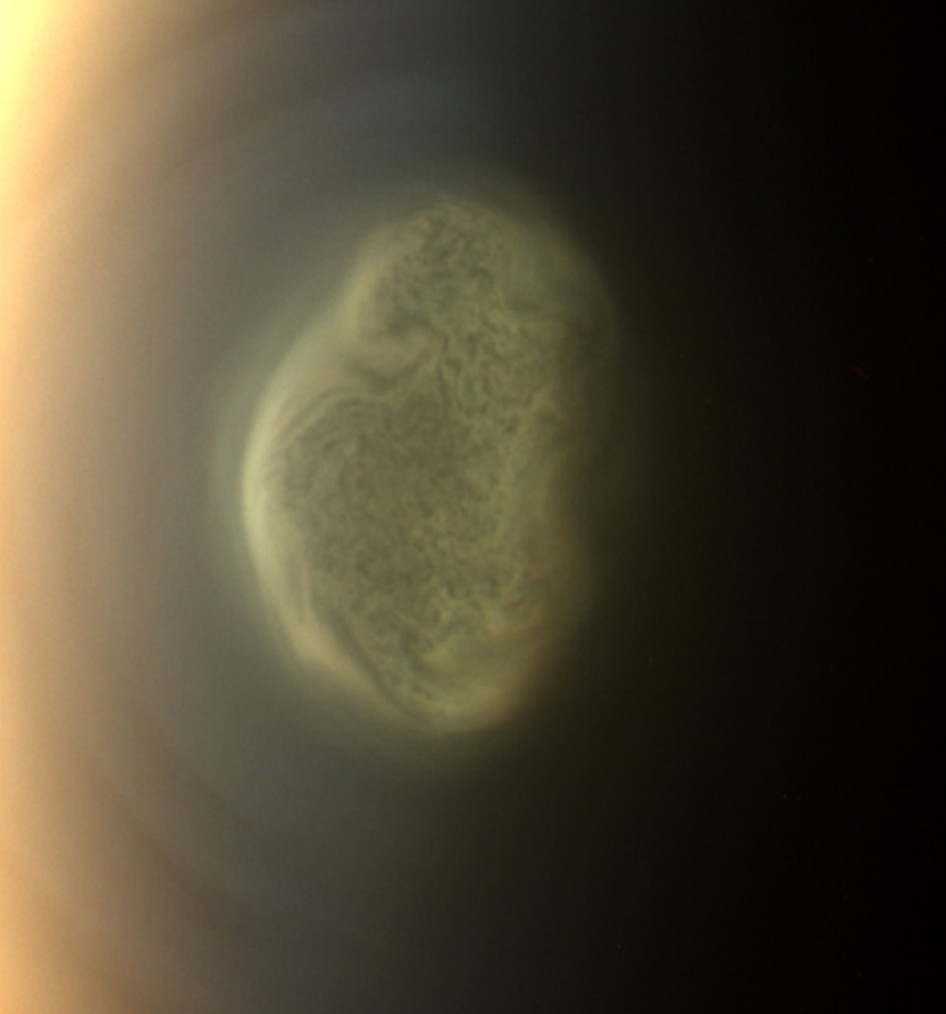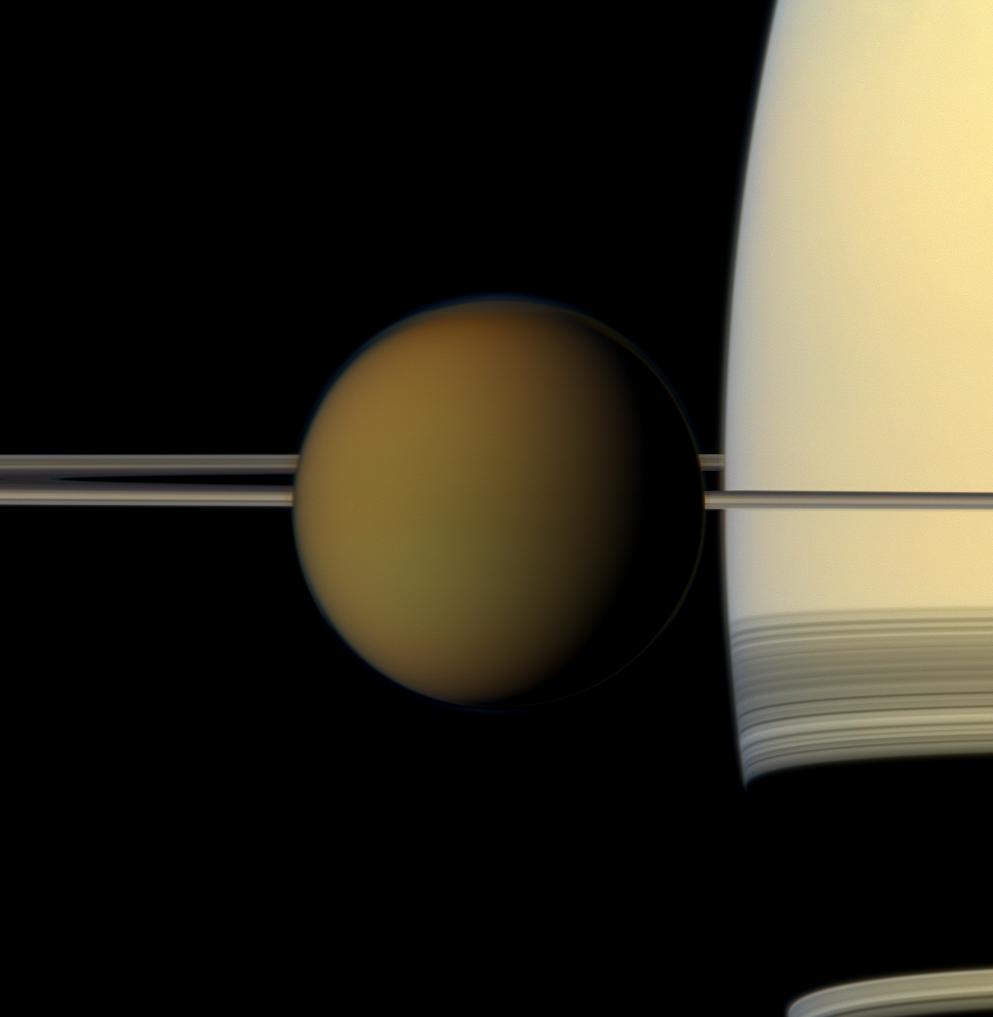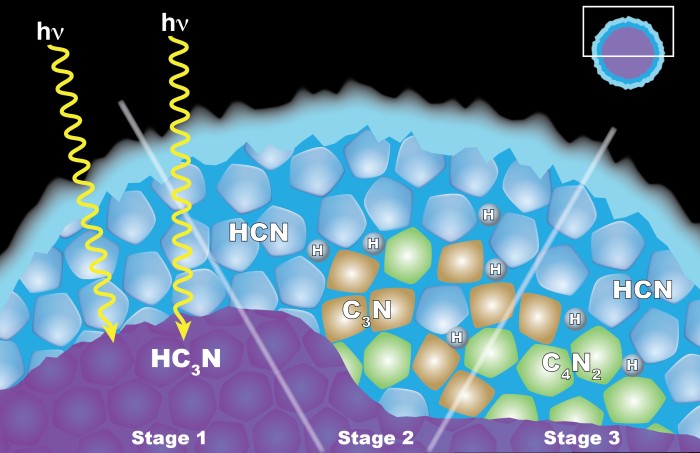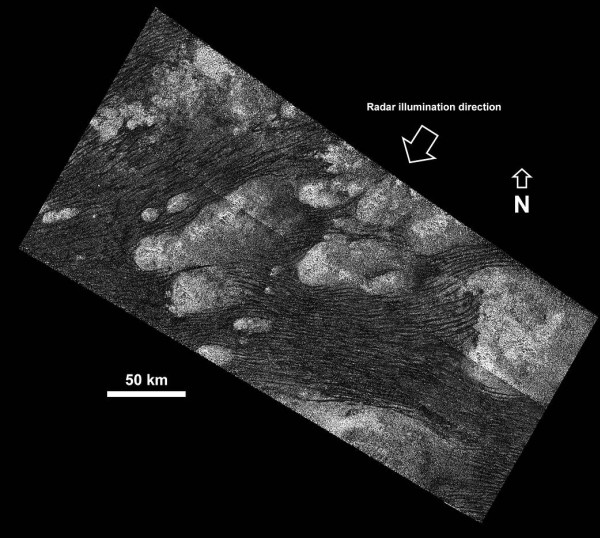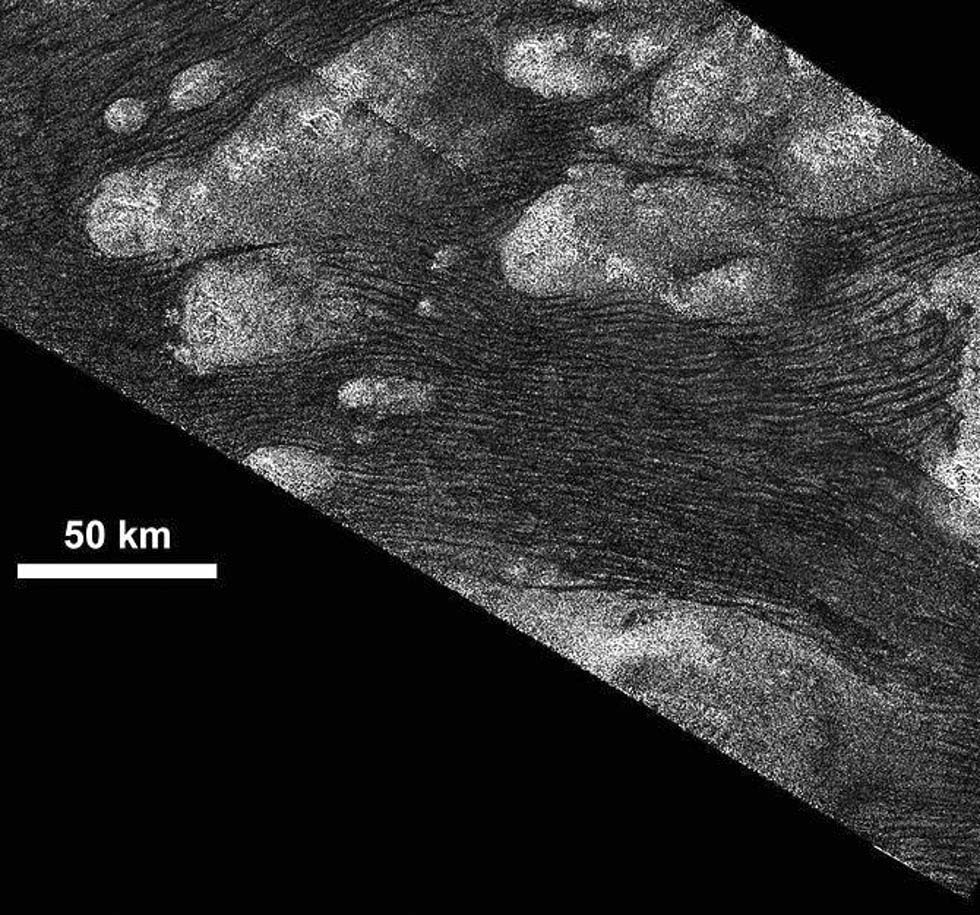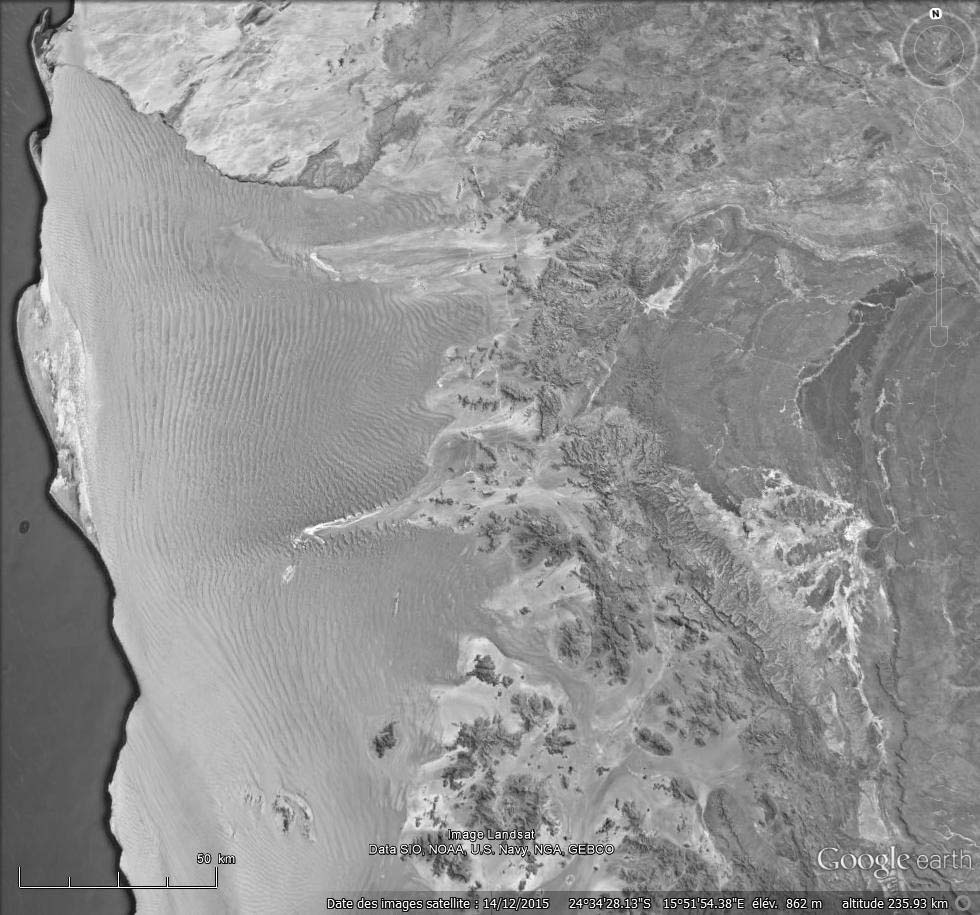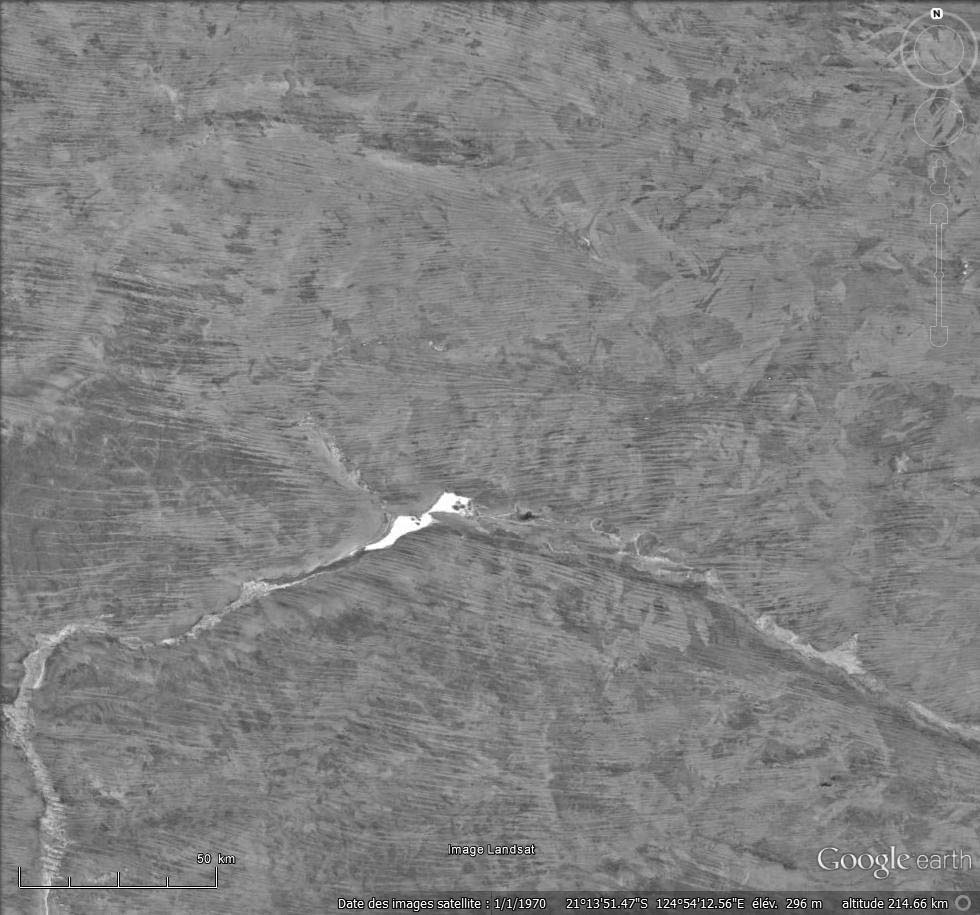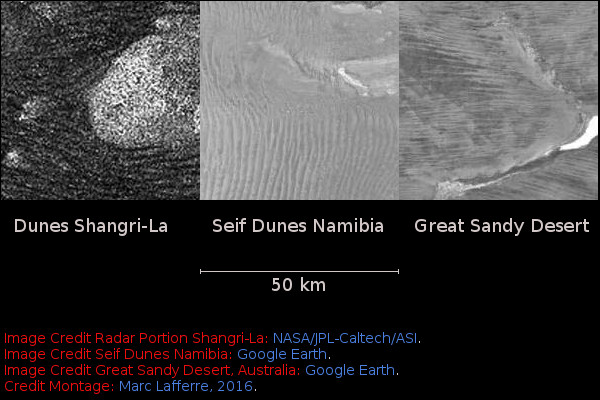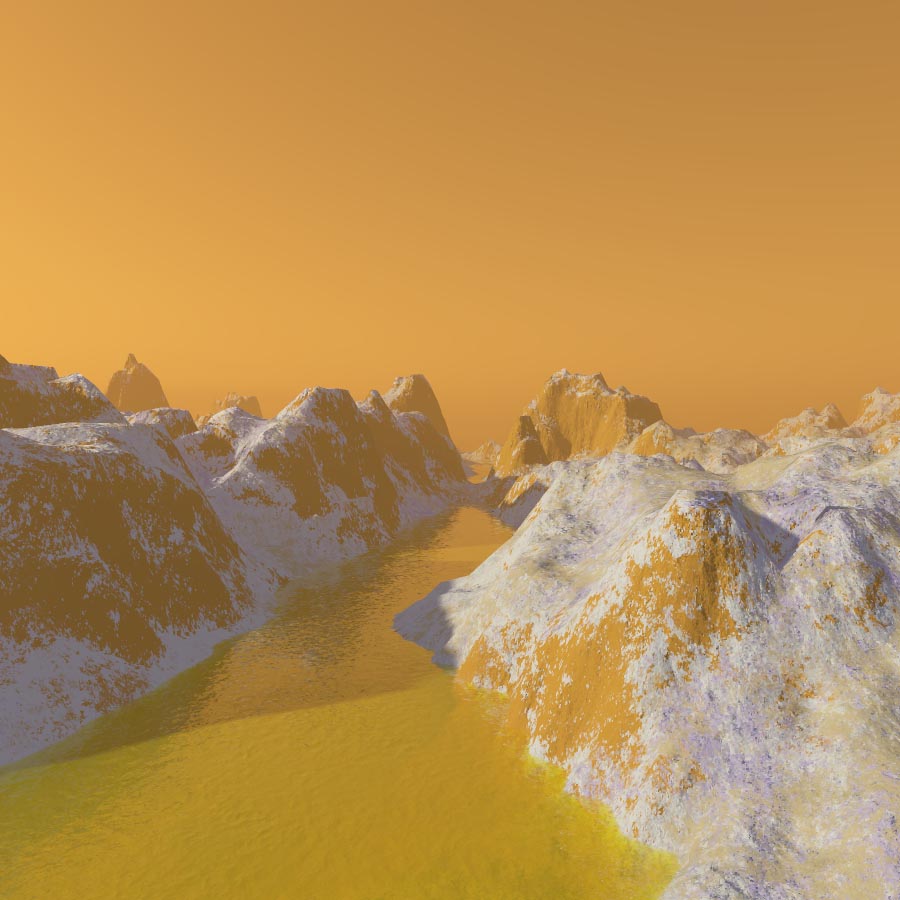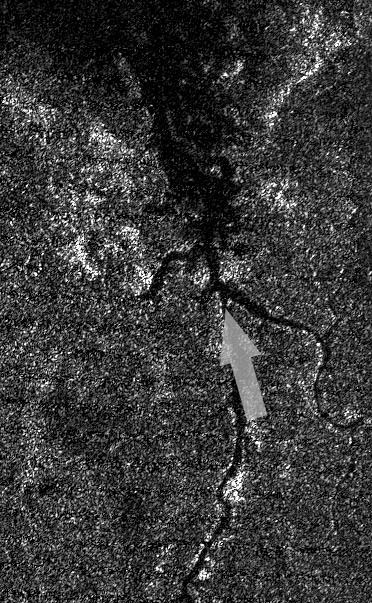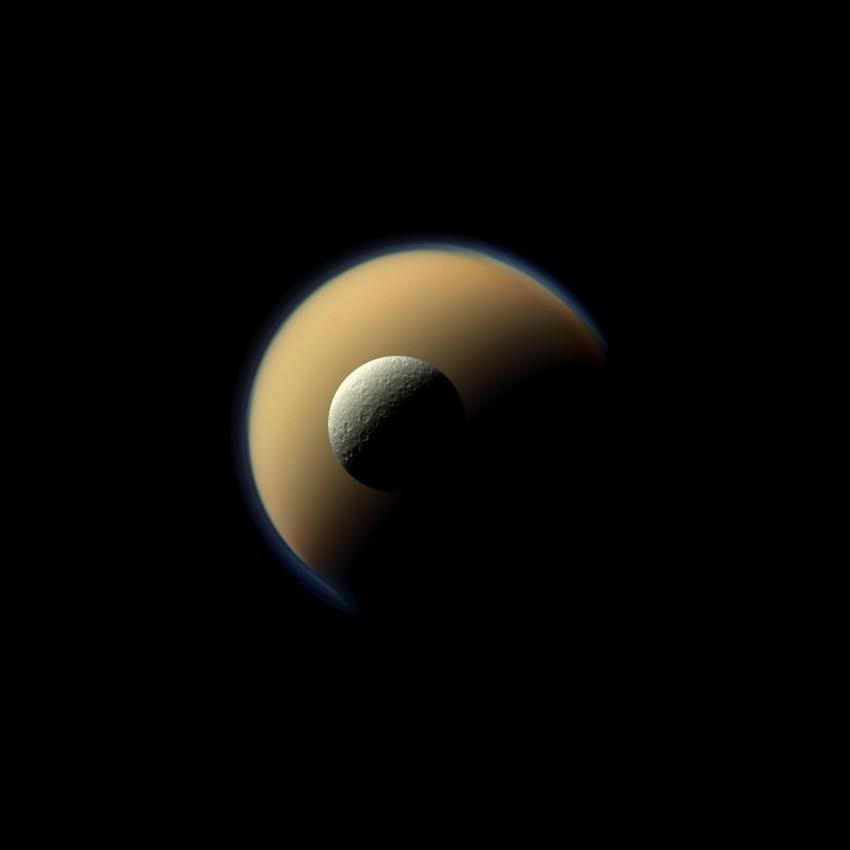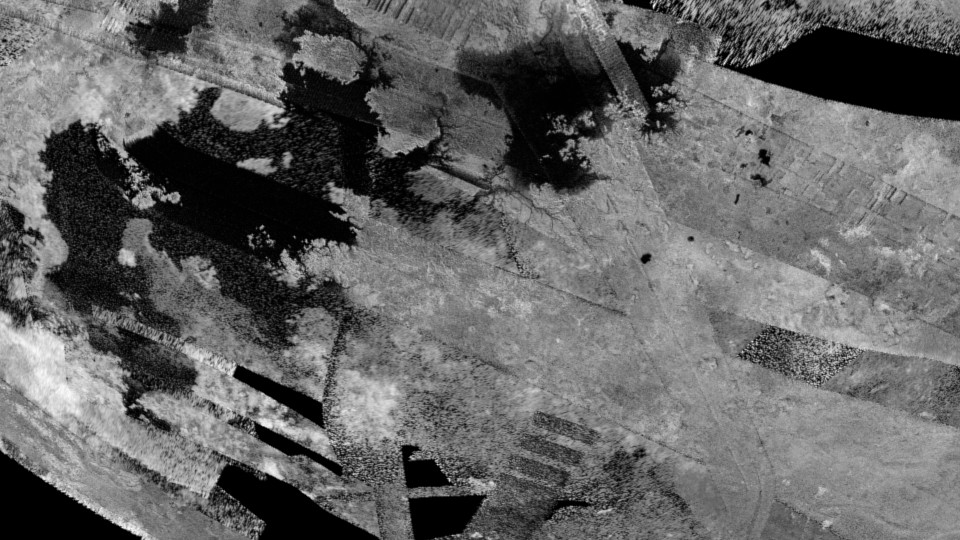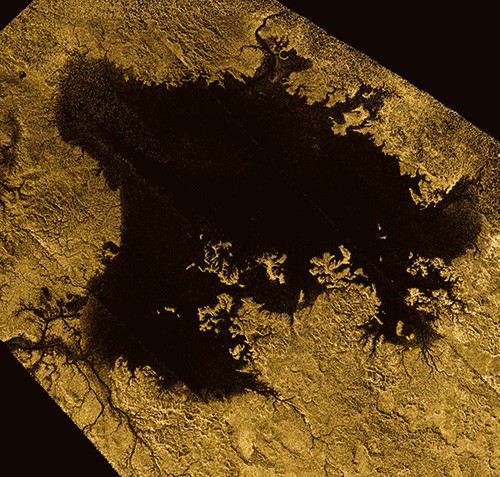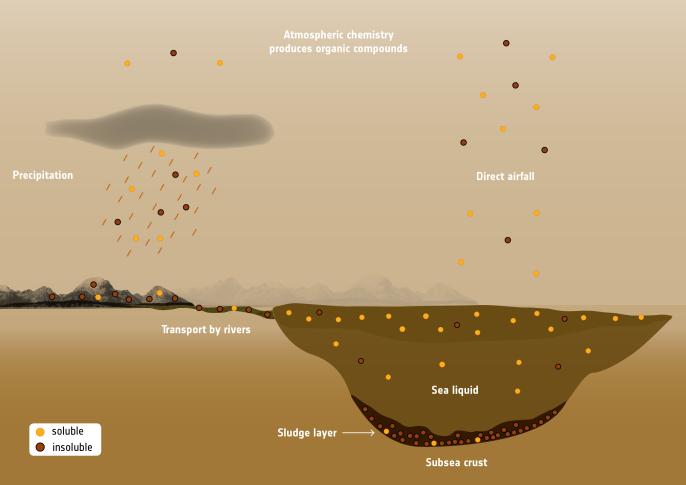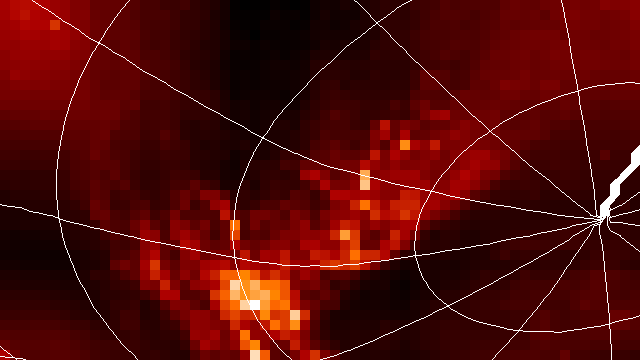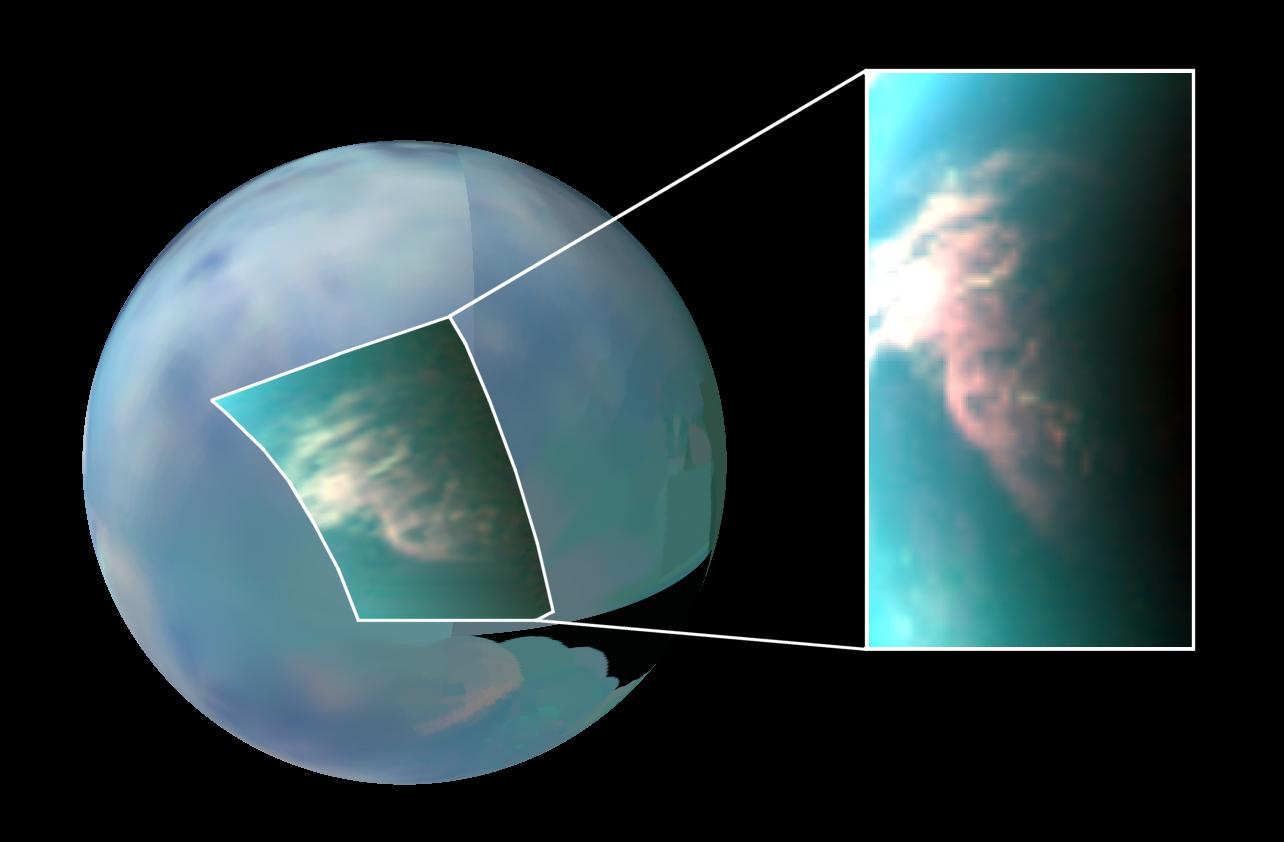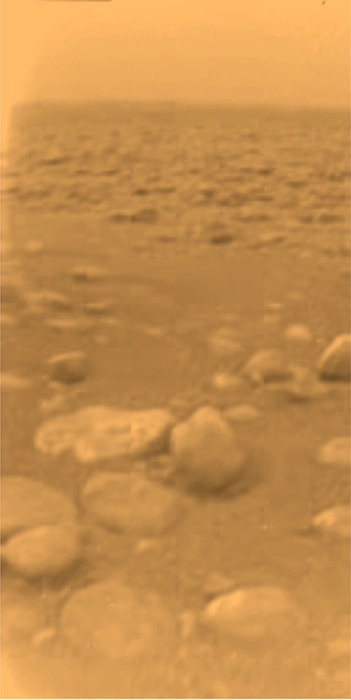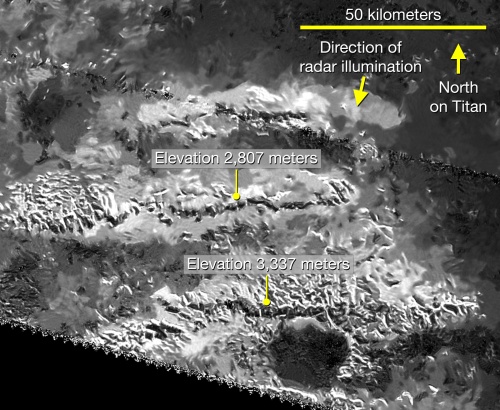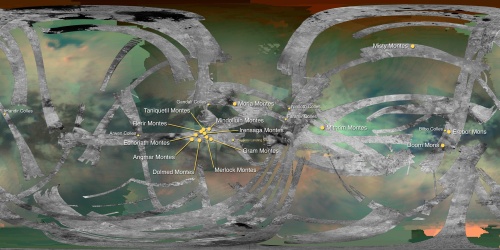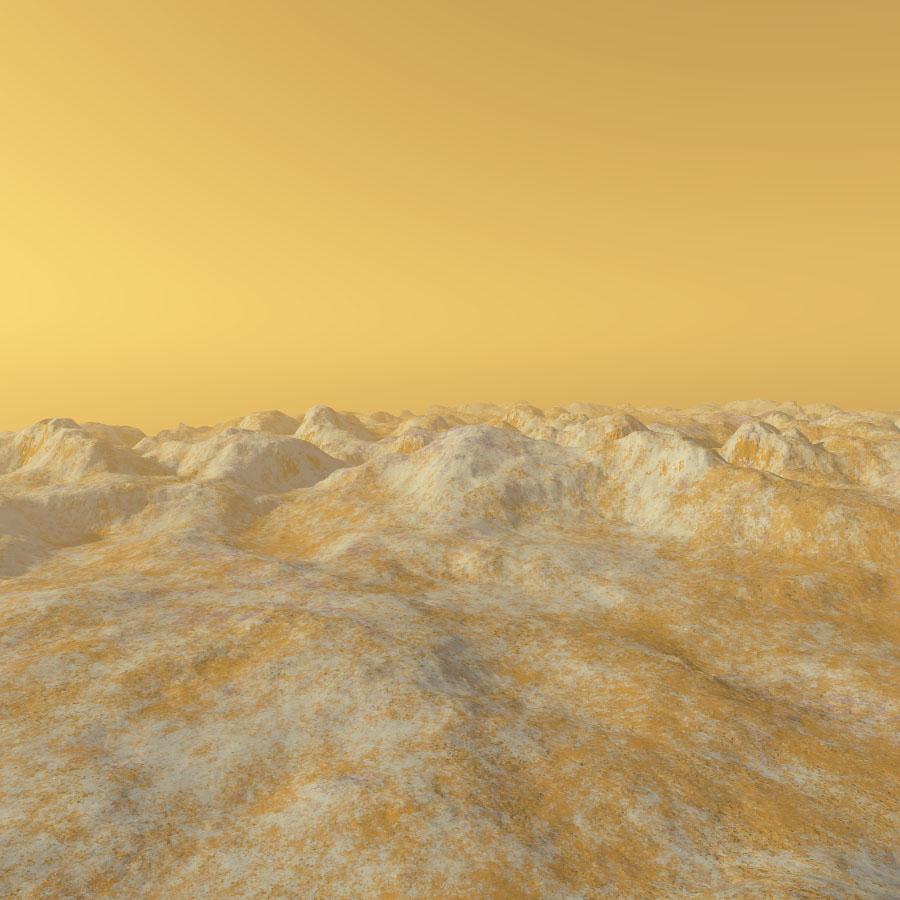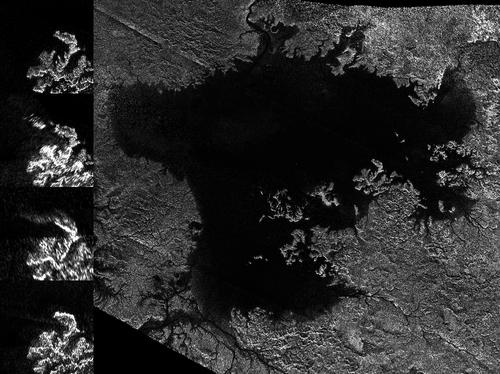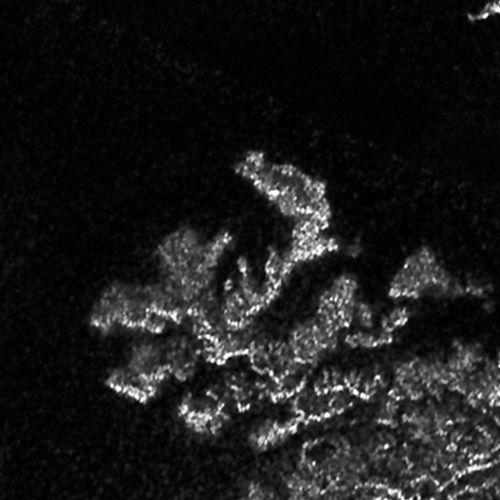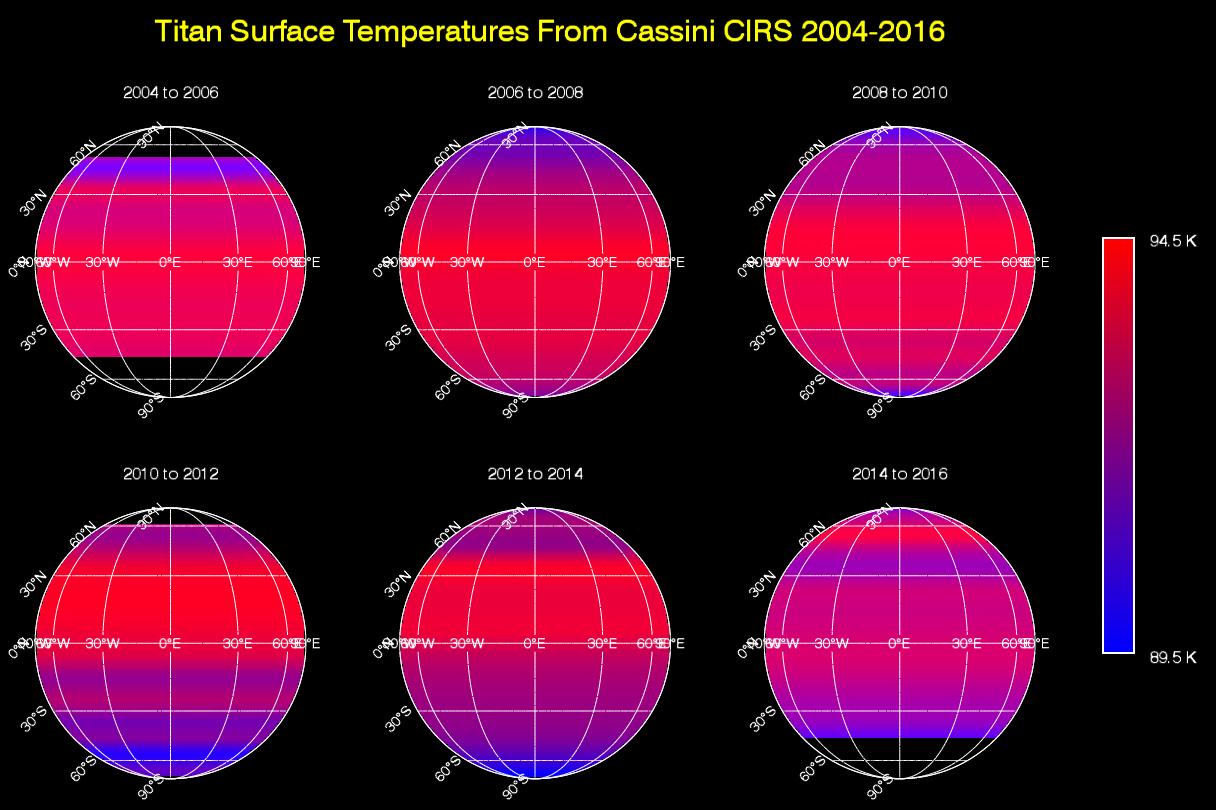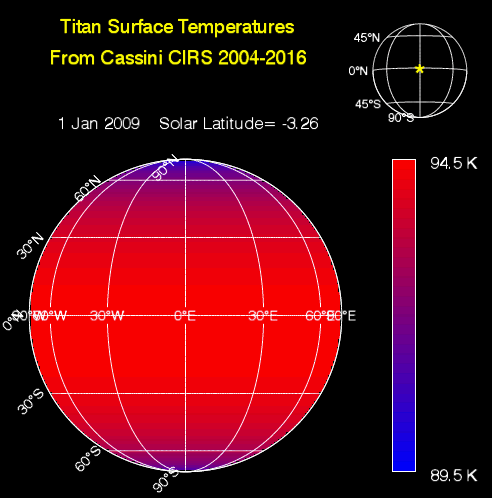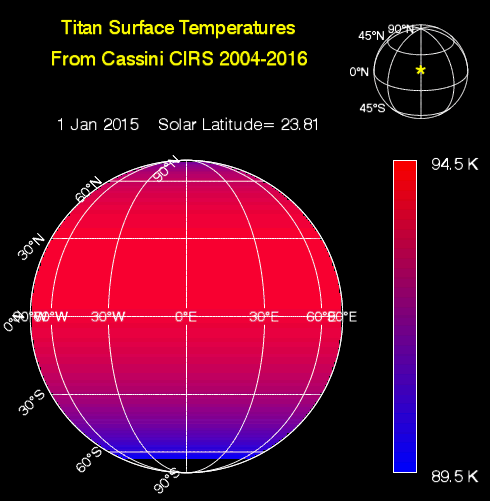Titan News 2016
December 6, 2016 : A Long-Term Transport Of Surface Liquids Between the North Polar Region And the South Polar Region of Titan ?
As the Cassini spacecraft approaches the end of its remarkable journey inside the Saturn System, researchers and the general public can now measure how fruitful the missions of the Cassini probe and the Huygens module have been since the beginning of the main mission in mid-2004. At the end of the year 2017, the Cassini probe will have performed over 125 close passes of the Opaque Moon and gathered key data regarding the Titanian atmosphere or surface. We have realized that the atmosphere of Saturn's largest moon is complex and dynamic with meteorological phenomena reminiscent of familiar meteorological phenomena on Earth.
A lot of people had imagined or anticipated the fact that we would find an ocean or big seas at low latitudes where the Huygens probe was expected to land but the hypothesis of a huge ocean in the low-albedo areas of the low latitudes was swept by images from the Huygens probe and Cassini data which revealed large fields of parallel and linear dunes extending over long distances in the dark equatorial or tropical areas. Those dunes, shaped by prevailing winds, seem to be similar in shape to the Seif Dunes observed in the Namib Desert or the dunes found in the Arabian Desert.
Researchers could also notice the clear contrast between bright areas and dark areas. In terms of contrast, Titan can rival the moon Iapetus but Titan is largely bigger than Iapetus and it has a significant atmosphere with a complex haze, cyclones, vortices or typical clouds. We now know that the Titanian landscape is remarkably varied with a limited number of craters due to erosional processes. By studying Titan's atmosphere, we may better understand the formation, the dynamics and the fate of planetary atmospheres such as the atmosphere of Venus, Mars or the Earth. The atmosphere of Titan is really interesting because it looks like our own atmosphere.
The atmosphere of the Opaque Moon is mainly composed of molecular nitrogen like the atmosphere of the Earth. Nitrogen represents approximately 95% of the composition of Titan's atmosphere whereas it represents about 78% of our atmosphere. The second most abundant compound in Titan's atmosphere is methane and not oxygen like in the atmosphere of our planet. Methane plays a key role in the meteorological cycle of Titan. A parallel can be drawn between the water cycle on Earth and the methane cycle on Titan. In the Troposphere of our planet, there are evaporation processes, condensation processes as well as precipitation processes, water rain or snow fall. In the Troposphere of Saturn's largest moon, there is also a meteorological cycle involving methane.
On Titan, water appears in its solid form at the level of the surface simply because the environmental temperature is too low to allow the presence of liquid water in direct contact with the air. The level of solar energy received at about 1,4 billion kilometers or 880 millions miles from the Sun is particularly low and the environmental temperature at the level of the ground on Titan is around minus 179 degrees Celsius, minus 290 degrees Fahrenheit or 94 Kelvin. That's the temperature which was recorded by the Huygens probe on the surface of Titan at a low latitude in the Adiri/Shangri-La region on January 14, 2005. The environmental temperature is low enough to allow the presence of liquid methane, liquid ethane or liquid propane on the surface. Let's point out, however, that the environmental temperature is too high to allow the presence of pure liquid nitrogen on the surface.
A liquid-water based life on the surface of Titan with trees, plants, animals or insects appears to be impossible due to the fact that liquid water is absent on the surface. Titan is in fact the second Terrestrial or icy world in the Solar System containing stable liquids on its surface. Radar data, infrared and near-infrared data obtained from the Cassini spacecraft since 2004 have allowed us to clearly identify lakes, seas and rivers in the high latitudes of the Orange Moon. The bodies of surface liquids appear to be composed of methane with trace amounts of ethane. Can they host a lifeform based on liquid methane or liquid ethane ? That is still an open question ! Athena Coustenis who is a director of research with the CNRS (Centre National de Recherche Scientifique) at the Paris-Meudon Observatory pointed out : « Titan has been one of the most exciting and unique objects in the solar system that we've been able to explore with Cassini.»
The rotation axis of Titan is inclined by about 27 degrees to the normal of its orbital plane which is higher than that of the Earth. That implies seasonal changes like on our own planet. The seasons of the Opaque Moon are particularly long since they last about 7 Terrestrial years and a Titanian year or Saturnian year lasts almost 30 Terrestrial years. Researchers need to perform a long-term study of Titan's atmosphere in order to better understand the climate or the meteorology of the giant moon. When the Cassini probe entered the Saturnian System in mid-2004, the southern hemisphere of Titan was experiencing the Summer season. A sea or a giant lake known as Ontario Lacus and dynamic cloud systems had been clearly identified in the high latitudes of the southern hemisphere. Today, the Winter season in the southern hemisphere is approaching. Will there be a progressive increase in the level or in the size of Ontario Lacus due to a higher level of condensation in the coming months or years ?
The Equinox occurred in 2009 on Titan. That was the start of the Spring season in the northern hemisphere and the start of the Autumn season in the southern hemisphere. A new high-altitude vortex which appears to be developing over the south polar region and which represents a « hot spot » has been clearly observed from the Cassini probe. This vortex may continue to grow and become as large as a giant vortex or cyclone observed over the north polar region during the Winter season and which had disappeared by 2011. Those atmospheric phenomena may be closely related to seasons. Researchers have noticed an intriguing dichotomy in the distribution of surface liquids between the south polar region and the north polar region. The north polar region appears to be much more humid. Will it change with the development of Summer in the northern hemisphere ?
The huge amount of data gathered regarding the dynamics and the composition of Titan's atmosphere and surface liquids is likely to help researchers improve their computer models of Titan's atmosphere. The complicated chemical processes taking shape in the Titanian atmosphere must be clearly understood in order to perform predictions or to understand the history of Titan's atmosphere. Due to the action of UV light from the Sun, methane should have disappeared from the hazy atmosphere. Why is it still there in such concentrations ? Is there an internal reservoir ? Is there an internal ocean of liquid methane ? These questions deserve an answer. According to the planetologist Jonathan Lunine who is an interdisciplinary scientist with the Cassini mission team and a professor of astronomy at Cornell, models of Titan's atmosphere bring new tests for models of our own atmosphere and they may help us better understand the dynamics of our remarkable atmosphere.
Jonathan Lunine showed that the study of Venus allowed us to better understand the process of greenhouse effect on Earth. On Titan, the overall greenhouse effect is relatively limited but on Venus, molecules of carbon dioxide or CO2 present in the heavy and opaque atmosphere engender an incredible greenhouse effect which raises the environmental temperature to levels higher than in a typical oven. Jonathan Lunine pointed out that the analyses of Venus performed in the 70s and 80s allowed researchers to « test whether we really understood the carbon dioxide greenhouse effect ». What happens if we adapt the models of Earth's atmosphere to the configuration of Venus ? The models are expected to predict what is supposed to occur.
Jonathan Lunine advanced : « And of course, there are therefore some applications to climate change on the Earth, because these same types of models are used to predict how our own atmosphere is changing... as we change it chemically. » Researchers like Jonathan Lunine suggest that the asymmetry or dichotomy in the concentration or in the amount of surface liquids between the north polar region and the south polar region may be closely related to a process of long-term transport or migration of surface liquids between the north polar region and the south polar region. Liquid methane may be progressively transported from pole to pole over timescales that are on the order of 100,000 years as Jonathan Lunine explains. This exotic process could be compared to the glacial cycles on the Blue Planet.
Prevailing models of Titan's atmosphere suggest that the wind will increase with the arrival of Summer in the northern hemisphere implying a rise in the size and frequency of waves on the methane sea or lake. Therefore, imaging waves from Cassini appears essential in order to test our models of Titan's atmosphere or our understanding of the hazy atmosphere. The Cassini probe can do that by sending a radio signal that will bounce into the sea or lake. Athena Coustenis explained that the south polar vortex composed of rare and complex chemicals represents a protection to molecules like methane which are normally destroyed by UV light from the Sun. Athena Coustenis pointed out : « I'm talking orders of magnitude increase in many of these constituents.» She added : « The south polar region is becoming a huge reservoir of enhanced material, in terms of gases, but also condensates - little icy particles – in the atmosphere of Titan. »
Athena Coustenis argued : « It's amazing that this strong difference with the south pole going into winter has come on so quickly. We expected to see this enhancement. What we didn't expect was for this to come on within months after we went past the equinox.» She explained : « [Now] we want to go and look for more complex organics. We want to understand how complicated is this organic chemistry in Titan's atmosphere.» Titan is a paradise for organics since the haze of the Orange Moon is made of organics and methane is composed of carbon. Researchers want to know what kind of organic molecules can develop in this environment. Will we find a « very organized chemistry » that can develop or replicate itself ? Jonathan Lunine pointed out : « Can that happen in liquids other than liquid water ? Does it have to be liquid water, or could it be something as different as liquid methane ? » He added : « Some people say that's preposterous, it's too cold or it's not the right stuff. But the history of science is replete with people saying 'that's ridiculous', and then someone finds that the idea really wasn't ridiculous. The only way we'll know is to sample the sea.»
Several icy moons or dwarf planets in the Solar System may host a subsurface ocean of liquid water which may be quite salty. Liquid water may be hidden beneath the icy crust of Titan. Jonathan Lunine advanced : « And Titan tells us about whether life more generally can begin in any kind of liquid medium that has sources of energy and has organics. We have to explore all three. » Researchers regularly unveil new findings regarding Titan such as the presence of canyons which are flooded with liquids. Athena Coustenis concluded at the AAS meeting in October : « It's such a huge amount of data, that I think at least three generations of astronomers coming will be able to analyze and work on that wealth of data in the coming years.» A new lander or boat sent to the surface of Kraken Mare, Ligeia Mare or Punga Mare may reveal a fantastic and exotic world. We're eager to see that !
The image above corresponds to a false-color mosaic of the disk of Titan revealing a multitude of lakes or seas in the north polar region. The orange areas close to the lakes or seas may correspond to dried-up pools and may be composed of evaporites. The view was generated on the basis of infrared data taken with the Visual and Infrared Mapping Spectrometer or VIMS of the Cassini probe on September 12, 2013. Image Credit: NASA/JPL-Caltech/University of Arizona/University of Idaho.
The image above represents a natural-color view of Titan obtained with the Narrow-Angle Camera of the Cassini spacecraft on October 7, 2013. One can clearly notice the lakes or seas found in the high latitudes of the northern hemisphere. The surface liquids are mainly composed of methane and ethane. The northern hemisphere is now approaching the end of the Spring season and the start of the Summer season. Image Credit: NASA/JPL-Caltech/Space Science Institute.
| The image in the upper part of this table represents a
simulated view of a land of lakes identified in the north polar region
of Saturn's largest moon Titan. The artistic view was generated on the
basis of the Shape From Shading Technique which brings information
regarding the relief or variations in altitude. The image found in the
lower part of this table represents the radar view used to produce the
simulated image. The radar view is a portion of a radar swath obtained
on October 9, 2006 from the Radar Mapper of the Cassini probe. The grey arrow indicates the orientation of the virtual
camera. The lakes may be mainly composed of methane and ethane.
Credit for the artistic view:
Marc Lafferre, 2016. |
- To get further information on that news, go to : http://www.space.com/34886-cassini-busy-final-year-at-titan.html.
November 11, 2016 : The Astonishing Views of Titan Obtained from Voyager 1 Made Researchers Eager To Plan A New Mission to Titan
The largest moon of Saturn appears to be a giant moon in our Solar System since it is the second largest moon in the Solar System. Ganymede, the largest moon of Jupiter, is the only moon bigger than Titan. Titan is even bigger than Mercury, the smallest planet in our Solar System. Titan is remarkable because it is part of the short list of Terrestrial bodies or icy bodies of our Solar System covered with a significant atmosphere. The atmospheric pressure on the surface of Titan is even bigger than that of the Earth at sea level. Researchers knew as soon as September 2, 1979 when the Pioneer 11 probe took 5 images of Titan from a distance of about 360,000 kilometers that Titan had a surprising atmosphere. They clearly realized however that Titan was too cold to harbor a lifeform based on liquid water.
The twin probes Voyager1 and Voyager 2 were going to capture new images of Titan, Saturn and some other Saturnian moons a few months or years later in 1980 and 1981. A Voyager 1 image representing a closeup view of Titan's atmosphere obtained on November 12, 1980, at a distance of approximately 13,700 miles or 22,000 kilometers from the Opaque Moon, revealed remarkable details of the complexity of Titan's atmosphere showing layers of haze or aerosols in the upper atmosphere of the Orange Moon. No surface details could be seen in the visible spectrum. As a result, the researchers of the mission were like a little child discovering a new world and asking questions. They were a little bit frustrated to a certain extent but they knew they would come back with a new mission. Some people have compared the closeup view of the atmosphere with its different layers with art painting since the image could be mistaken with bad abstract art. The scientists of the mission regarded this view as a masterpiece and as a first step in our understanding of the dynamics of Titan's atmosphere.
The Cassini spacecraft and the Huygens module which started their mission inside the Saturnian System in mid-2004 appear to be the perfect successors of the Pioneer 11 spacecraft, the Voyager 1 probe and the Voyager 2 probe. The amount of data collected regarding Saturn, its rings and its numerous moons such as Enceladus, Titan or Iapetus represents a treasure of scientific data and inspiring images for scientists and the general public. The relatively limited amount of data regarding Titan, Saturn and some other Saturnian moons captured from Pioneer 11, Voyager 1 and Voyager 2 was sufficient to fuel our imagination and to motivate engineers and researchers to go back to the system of the Ringed Planet. Linda Spilker who is a Voyager team member who later took part in the Cassini mission to perform the in-depth study of the Saturnian System argued : « Certainly, smoggy Titan is one of those images that led us to say we had to go back. We wanted to know what the surface looked like. »
The Cassini-Huygens mission was well suited to see what Pioneer 11, Voyager 1 and Voyager 2 had never seen regarding Saturn's largest moon. The Huygens probe carried out an atmospheric descent and a soft landing on January 14, 2005 collecting a huge amount of data including remarkable images such as panoramic views and a color view taken from the surface. We were in a position to appreciate some similarities between typical landscapes on Earth and the landscape of Titan. The panoramic views clearly showed fractures or dark drainage channels on bright hills and a significant contrast between the bright hills and a relatively flat terrain or plain which was perhaps an ancient sea. The images of Titan's soil taken from the ground after the touchdown clearly showed strongly eroded stones or pebbles suggesting the presence of an ancient river or brook. Researchers realized that there is probably a seasonal meteorological cycle in the region involving evaporation processes, condensation processes, cloud formation and rainfall processes.
A Titanian year is very long since it lasts almost 30 Terrestrial years. A season on Titan represents about 7 Terrestrial years. As a result, we needed to perform a very long study of Titan's atmosphere in order to better understand its mechanics or dynamics. The Cassini orbiter which has performed multiple flybys of the Opaque Moon since mid-2004 has gathered a huge amount of data regarding the meteorological cycle on Titan and the topography and the landscape. The Cassini spacecraft can see through the atmosphere or haze thanks to its near-infrared or infrared eyes and thanks to its radar instrument. Before the landing of the Huygens probe, some astronomers or researchers like André Masclet of the astronomical society GAPRA believed that the dark low-latitude areas which mark a contrast with bright areas represented seas or oceans of methane, ethane or hydrocarbons. We know, now, that they are mostly composed of Seif Dunes or linear and parallel dunes extending over long distances under the action of prevailing winds. There are icy areas like Adiri or Xanadu which appear bright in the infrared or near-infrared spectrum but the dark areas found at low latitudes are dominated by dunes which reveal similarities with dunes found in the Namib Desert or in the Arabian Desert.
The discovery of Ontario Lacus, a kidney-shaped lake or sea found in the high latitudes of the southern hemisphere, was the first pool of surface liquids identified outside our own planet. We know, now, two worlds containing stable pools of liquids on their surface, the Earth and Titan. The VIMS instrument of the Cassini probe which can see in the infrared or near-infrared spectrum as well as the Radar Mapper of the Cassini spacecraft which can see or map the topography even on the night side of the moon have allowed us to determine that most lakes, seas and rivers on Titan are located in the high latitudes of the Orange Moon. The north polar region appears to be the most humid area of Titan today. Kraken Mare is the largest pool of liquids in the high latitudes of the northern hemisphere and on the entire moon and it can be considered a sea due to its remarkable size. Numerous islands have been identified in the big pools of liquids found in the north polar region.
The meteorological cycle on Titan reveals striking similarities with the meteorological cycle on our planet. Obviously, the environmental conditions on Titan are very different from the environmental conditions on Earth since the environmental temperature on Titan is about minus 180 degrees Celsius, minus 292 degrees Fahrenheit or 93 Kelvin. A parallel can be drawn, however, between the water cycle on Earth and the methane cycle on Titan. Methane or ethane on Titan can evaporate, condense and form clouds like water on Earth. Clouds on Titan can generate methane or ethane rainfall like clouds on Earth with H2O. However, methane and ethane in their liquid form on the surface of Titan may be particularly sensitive to the amount of energy received from the Sun. Remarkably Strong evaporation processes may occur during the Summer season in the polar region. The Summer season in the northern hemisphere will start next year, in 2017. What will happen to the shape or the dynamics of Kraken Mare, Ligeia Mare or Punga Mare found in the high latitudes of the northern hemisphere ? Will they progressively diminish in size or shape or will their level decrease due to relatively strong evaporation processes ? Will there be more clouds in the area ?
The Voyager probes revealed in fact several intriguing worlds and the small icy moon Enceladus is undoubtedly one of the most fascinating worlds identified in the Saturnian System. The Voyager 2 probe clearly showed that a portion of the surface of Enceladus was remarkably smooth with the absence or quasi absence of craters. Researchers became aware that the surface was quite recent or that some active tectonic or surface processes were occurring. Thanks to the images acquired from the Cassini probe, we know, now, that there are fractures from which multiple geysers take shape in the south polar region. Those topographic fractures represent the famous Tiger Stripes. An internal ocean or pockets of liquid water may be hidden beneath this smooth surface or beneath those fractures. The Voyager probes also unveiled other remarkable phenomena such as the first signs of grooves and spokes in the complex system of rings around the Gas Giant Saturn. They also revealed the intriguing large-scale hexagon engulfing Saturn's north pole.
The Voyager 1 and 2 probes which were launched in 1977 are still operating today. Voyager 2 has also visited the System of Uranus and the System of Neptune and is now leaving our Solar System at a speed of 38,000 miles or 61,000 kilometers per hour. The Voyager 1 probe which left the Solar System in 2012 was forced to end its planetary mission with the exploration of the Saturnian System in order to get a good look of the intriguing moon Titan. Linda Spilker who now acts as project scientist for Cassini pointed out : « When I started working on Voyager, I had no idea how many fundamental new discoveries we would make. » She added : « There were times when I literally had to plan when to sleep. I would bring my sleeping bag to work and catch a few hours of sleep in between the times of the most exciting images. » She advanced : « What motivates me is the sense of being an explorer, of seeing worlds and vistas that no one has seen before.» She concluded : « The Voyager discoveries, such as the beautiful structure in Saturn's rings, our first views of Saturn's moons close up, Titan's hazy atmosphere, and the mysterious Saturn hexagon. Each set of tantalizing pictures left me with a sense of wanting to see more. » Planetary exploration is going ahead at a relatively slow pace but we regularly gather new clues which are precious and which may help us better understand our environment.
The image above represents a view of Titan produced on the basis of five images acquired from the Pioneer 11 probe on September 2, 1979. Researchers realized at that time that Saturn's largest moon was covered with an opaque atmosphere completely hiding the surface like the atmosphere of Venus. Image Source: Wikipedia.
The image above reveals a portion of Titan's atmosphere in enhanced colors collected from the Voyager 1 probe on November 12, 1980. One can notice the upper layers of Titan's opaque and orange atmosphere. The images of Titan obtained from Voyager 1 captivated our imagination and made scientists eager to send a new mission to this enigmatic world. Image Source: Wikipedia.
The image above reveals a closeup view of Titan's atmosphere in false color, obtained from the Voyager 1 probe on November 12, 1980. One can notice the multiple haze layers found in the upper limits of the opaque atmosphere. Complex chemical processes occur in the atmosphere of the Orange Moon under the action of UV light from the Sun and new molecules, hydrocarbons or organics take shape. Image Credit: NASA/JPL.
The view above reveals Enceladus, one of the most intriguing moons in orbit around the Gas Giant Saturn. The image represents a mosaic of data obtained from the Voyager 2 probe on August 28, 1981. One can notice a remarkably smooth surface on most of the disk as well as grooves or fractures suggesting an active geology. Image Credit: NASA/JPL/USGS.
- To get further information on that news, go to: https://saturn.jpl.nasa.gov/news/2962/saturn-we-had-to-go-back.
November 5, 2016 : New Cassini Data Reveal Dynamic Clouds of Methane Moving At High Northern Latitudes Over The Humid Area On Titan
New infrared views of the high latitudes of the northern hemisphere of Saturn's largest moon Titan reveal the dynamics of clouds forming or moving over the land of lakes and seas. The images were obtained on October 29 and 30, 2016 from the Cassini spacecraft with the Narrow-Angle Camera using infrared filters in order to make surface features visible and to unveil tropospheric clouds which appear to be composed of methane. Researchers were in a position to produce a movie sequence of the area representing 11 hours on the basis of one frame taken every 20 minutes. The animation clearly shows the formation, the development or the significant dynamics of clouds at high latitudes in the northern hemisphere or in the north polar region.
The new images clearly reveal the shape of the famous system of lakes and seas located in the high latitudes of Titan's northern hemisphere. They also show the development of patches of clouds near the lakes or seas as well as relatively thin and long clouds drifting at high latitudes between 49 and 55 degrees north latitude. Several systems of clouds can be seen developing, moving over the surface and fading during the sequence of infrared frames. The movie shows a persistent cloud activity during the relatively short observation. Individual clouds which look like cirrus clouds on Earth can be seen forming, developing and then fading. Planetologists have been in a position to determine that the cloud speed is approximately 14 to 22 miles per hour or 7 to 10 meters per second.
The small clouds observed close to the lakes or seas in the north polar region fade relatively rapidly over the course of the animation. Those clouds seem to be moving slowly compared to the streaks of clouds drifting at high latitudes. Researchers have been in a position to determine that the system of clouds close to the lakes or seas is moving at a speed of approximately 0.7 to 1.4 miles per hour or 1 to 2 meters per second. That kind of cloud dynamics with clouds forming, developing and fading in a certain way brings key information regarding Titan's meteorology. They regularly gather new clues regarding the relationship between cloud activity and seasonal factors. The animations which are composed of multiple frames enable us to easily discern noise from clouds or fog. Noise can be engendered for instance by cosmic rays hitting the detector of the device.
This set of images collected by the Narrow-Angle Camera of the Cassini probe allowed researchers to produce a scientifically useful animation revealing a short-term cloud dynamics. This campaign of observations represented the best opportunity in 2016 to analyze the characteristics of clouds in the high latitudes of the northern hemisphere over a short period of time. In the year 2016, the Cassini probe has intermittently acquired images unveiling clouds across the northern mid-latitudes of the Opaque Moon or over the north polar area where numerous lakes, seas and rivers can be clearly identified. Unfortunately, most of this year's observations aiming at monitoring cloud activity or cloud dynamics have been short snapshots captured days, or weeks, apart. As a result, researchers were not in a position to precisely analyze the formation or the evolution of clouds on Titan and in particular in the high latitudes of the Orange Moon.
Since the beginning of the Cassini/Huygens mission in mid-2004, scientists have had the opportunity to perform an in-depth study of Titan's climate and meteorology and to see the seasonal evolution of this intriguing moon. When the Cassini probe entered the Saturnian System, the southern hemisphere was experiencing the Summer season whereas the northern hemisphere was experiencing the Winter season. Due to seasons, strong meteorological changes can occur on Saturn's largest moon. The obliquity of Titan is higher than that of the Earth which implies relatively strong changes in the amount of solar energy received by high-latitude areas. A Titanian year is very long, lasting almost 30 Earth years. And each season lasts approximately 7 Earth years. The last equinox occurred in August 2009 with the start of the Spring season in the northern hemisphere and the start of the Autumn season in the southern hemisphere. The Summer season in the northern hemisphere and the Winter season in the southern hemisphere are now approaching. The next solstice will occur in May 2017.
During the Summer season in the southern hemisphere, several dynamic cloud systems had been clearly identified over the high latitudes of the southern hemisphere in the region of Ontario Lacus, the first lake or sea observed on Titan. Researchers could study the area thanks to infrared or near-infrared views obtained from the VIMS of the Cassini probe. And Ontario Lacus could be clearly seen in the radar views acquired from the Radar Mapper of the Cassini spacecraft. Now, the area of Ontario Lacus is in the shade for infrared or near-infrared views and Cassini scientists can obtain remarkable views of the north polar area which is expected to display a strong meteorological activity or cloud activity due to the action of relatively strong solar radiations.
Yet, researchers are almost surprised to observe a lower-than-expected level of cloud activity in the high latitudes of the northern hemisphere where the Spring season is coming to an end. They may not have fully understood the mechanics of Titan's changing seasons because models of the climate of the Orange Moon have predicted a stronger meteorological or cloud activity during early northern Summer than what has been seen so far. How can we explain this shift ? Have we clearly determined the exact nature of the lakes, seas and rivers which are likely dominated by methane and ethane ? Are there internal sources or an internal reservoir of methane hidden beneath the surface of the north polar region ? Researchers need more clues to fully understand the methane cycle on Titan but the Cassini mission is coming to an end with a great plunge towards Saturn scheduled in September 2017 around the Summer solstice in the northern hemisphere of the Opaque Moon.
Some scientists expect now that the level of the lakes, seas and rivers found in the high latitudes of the northern hemisphere will progressively decrease due to the higher level of solar energy received which is likely to engender a higher level of evaporation. We may expect more clouds or more cyclones in the north polar region. In parallel, the level of Ontario Lacus located in the high latitudes of the southern hemisphere may progressively increase due to the progressive decrease in the amount of solar energy received, engendering a higher level of condensation processes in the area. A huge high-altitude cyclone over the south polar region has already been clearly identified. This cyclone is reminiscent of the vortex identified over the north polar region during the Winter season in the northern hemisphere.
Scientists have been puzzled by the remarkable dichotomy between the humidity level in the south polar region and in the north polar region. So far, the north polar region appears to be the most humid area on Titan with major lakes or seas like Punga Mare, Ligeia Mare or Kraken Mare. A multitude of rivers or networks of drainage channels have been clearly identified as well as islands like on our own planet. A parallel has been drawn between the water cycle on Earth and the methane cycle on Titan. There are evaporation processes, condensation processes generating clouds and precipitation processes on Titan like on Earth. In the harsh environment of Titan where environmental temperatures can be as low as minus 180 degrees Celsius, minus 292 degrees Fahrenheit or 93 Kelvin and where the atmospheric pressure can reach 1467 hPa, methane can play the role of water on Earth to engender an exotic meteorology.
Methane appears to be the second most abundant gas in the atmosphere of Titan representing up to 5 percent of its composition. There are remarkable similarities between the atmosphere of Titan and the atmosphere of the Earth since nitrogen molecules represent the main compounds of both atmospheres. But the atmosphere of Titan is completely opaque in the visible spectrum from outer space due to a strange haze engendered by interactions implying the action of ultraviolet light from the Sun. Curiously, the low-latitude areas of the Orange Moon which appear dark in the infrared or near-infrared spectrum are dominated by Seif dunes or linear and parallel dunes extending over long distances. Are they the outcome of ancient oceans or seas like in the Sahara desert on Earth ? Are there heavy rainfalls or monsoon events in the area from time to time ? The Huygens probe clearly revealed bright mountains or hills composed of dark drainage channels or fractures during its atmospheric plunge. That's the sign that the region of Shangri-La and Adiri has likely encountered rainfall or even heavy rainfall in a relatively recent past. The landing site also revealed strongly eroded stones or pebbles implying the presence of a former river or brook where the Huygens probe landed. The study of Titan's atmosphere is captivating and is likely to help us better understand the mechanics of our own atmosphere. Titan's atmosphere can be considered a prebiotic natural laboratory since it produces multiple organics or hydrocarbons which can be familiar on Earth.
The image above unveiling the high latitudes of Titan's northern hemisphere reveals one of the images acquired from the Cassini probe in the infrared spectrum during the observation campaign for cloud activity which occurred on October 29 and October 30, 2016. One can clearly see the land of lakes and seas found at high latitudes in the northern hemisphere as well as bright features or bright patches corresponding to dynamic clouds. Image Credit: NASA/JPL-Caltech/Space Science Institute.
The image above reveals one of the views obtained from the Cassini probe in the infrared spectrum during the observation campaign for cloud activity which was performed on October 29 and October 30, 2016. One can clearly notice in particular streaks of clouds moving at high latitudes in the northern hemisphere around the famous land of lakes and seas. Image Credit: NASA/JPL-Caltech/Space Science Institute.
- To get further information on that news, go to : http://saturn.jpl.nasa.gov/news/2960/watching-summer-clouds-on-titan.
October 21, 2016 : Cassini Data Reveal Radical Seasonal Changes On Titan With A Vortex Developing Over The South Polar Region
Since the arrival of the Cassini-Huygens spacecraft into the Saturnian System in mid-2004, researchers have had the opportunity to identify significant seasonal changes in the dynamics, in the composition or in the temperature of Titan's atmosphere. When the Cassini-Huygens spacecraft reached Saturn and its neighbourhood in 2004, the northern hemisphere was experiencing the Winter season whereas the southern hemisphere was experiencing the Summer season. A Titanian year lasts almost 30 Earth years and each Titanian season lasts approximately 7 Earth years. The Spring season in the northern hemisphere and the Autumn season in the southern hemisphere occurred in August 2009 with the Equinox. Now, Winter is approaching in the southern hemisphere and Summer is approaching in the northern hemisphere. As a result, researchers have been in a position to monitor seasonal changes in the complex atmosphere of Saturn's largest moon.
Like on Earth, clouds on Titan can develop in the Troposphere or in the Stratosphere. A large ethane cloud system engulfing the north polar region had been clearly observed during the Winter season in the northern hemisphere. Now, Winter is approaching in the southern hemisphere and a strong vortex, enriched in trace gases, is taking shape and growing in the upper atmosphere over the south polar region. This vortex or cyclone is reminiscent of the large ethane cloud system which had been seen over the north polar region. There seems to be a seasonal symmetry in terms of atmospheric phenomena, to a certain extent, between the north polar region and the south polar region.
The observations clearly reveal a polar atmospheric reversal since the Cassini probe attained the Saturn System in mid-2004. Doctor Athena Coustenis of the Observatoire de Paris, who is presenting results at the joint 48th meeting of the American Astronomical Society's Division for Planetary Sciences and 11th European Planetary Science Congress pointed out : « Cassini's long mission and frequent visits to Titan have allowed us to observe the pattern of seasonal changes on Titan, in exquisite detail, for the first time.» Even in a harsh environment with extremely low temperatures, strong meteorological or atmospheric changes can take shape over time. Athena Coustenis argued : « We arrived at the northern mid-winter and have now had the opportunity to monitor Titan's atmospheric response through two full seasons. Since the equinox, where both hemispheres received equal heating from the Sun, we have seen rapid changes.»
The rotation axis of Saturn's largest moon is inclined by about 27 degrees which allows relatively strong changes in the amount of solar energy received by each polar area depending on seasons. During the Summer season, the amount of solar energy received from the south pole is higher than the solar energy received during the Winter season which implies an atmospheric circulation of heat involving a pole-to-pole cycle of warm gases rising at the Summer pole and cold gases going down at the Winter pole due to their increasing weight. The observations performed from the Cassini probe have allowed us to study the remarkable seasonal transition between Winter and Spring or Summer and Autumn at the time of the Equinox which occurred in August 2009. Researchers were in a position to identify a large-scale reversal of this atmospheric system immediately after this Equinox.
The Cassini scientists have also been able to measure environmental temperature variations for each hemisphere over time. Temperature changes are not completely symmetrical for each hemisphere since the level of temperature drop in the southern polar Stratosphere was lower than the level of temperature rise in the northern polar Stratosphere in the last few years. Since the end of the Summer season in the southern hemisphere and over the last four years, a 40-degree Celsius decrease in temperatures in the southern polar Stratosphere has been measured. In parallel, the warming level in the northern polar hemisphere which is now approaching the Summer season appeared lower or was more gradual. Researchers could notice stable temperatures during the early Spring but a 6-degree Celsius rise in temperatures has been recorded since 2014. Perhaps that the pace in the environmental temperature of the northern polar region will accelerate in the near future since the Solstice and the beginning of the Summer season in the northern hemisphere are approaching.
The vortex or the cyclone observed at high altitude, in the Stratosphere of the south polar region became remarkably big and impressive within months following the Equinox marking the start of the Autumn season in the southern hemisphere. This intriguing atmospheric feature could take the shape of an atmospheric « hot spot » at a high altitude. In parallel, over the northern polar region which experienced the start of the Spring season in 2009, the large ethane cloud or the big cyclone had almost vanished by 2011. As a result, one can clearly notice the strong influence of sunlight and solar energy upon the dynamics and the composition of the atmosphere, especially in the high latitudes or in the polar areas of the Opaque Moon.
What is the composition of the vortex developing in the Stratosphere of the southern polar region which is more and more in the shadow as the Winter season approaches ? Cassini scientists have been in a position to identify a rapid build-up of trace gases inside the polar vortex. The emergence or the development of trace gases within the vortex is closely related to the absence of ultraviolet light coming from the Sun. Among the trace gases present in this growing vortex, one can mention complex hydrocarbons and nitriles such as methylacetylene and benzene which had only been observed at high northern latitudes before the observation of this phenomenon.
Athena Coustenis and her colleagues have been in a position to generate computer models regarding the climate, the meteorology and atmospheric phenomena. They can perform predictions regarding the dynamics and the composition of the vortex or cyclone now. Athena Coustenis advanced : « We've had the chance to witness the onset of winter from the beginning and are approaching the peak time for these gas-production processes in the southern hemisphere. We are now looking for new molecules in the atmosphere above Titan's south polar region that have been predicted by our computer models. Making these detections will help us understand the photochemistry going on. »
One can notice that, in the northern hemisphere of the Orange Moon, the trace gases have persisted well beyond the Winter season towards the Summer period. On the basis of theory, simulations or computer models, a slow chemical destruction process of trace gases under the action of radiations from the Sun is predicted to occur, with species vanishing at a different speed or rate depending on their chemical lifetimes. Yet, one can notice that, since early 2016, an area of depleted molecular gas and aerosols has taken shape and grown across the whole northern hemisphere between an altitude of 400 and 500 kilometers, implying a complex dynamical effect beginning at high altitudes in the hazy atmosphere. There can be radical changes in the atmosphere of Titan due to seasonal changes. The cyclones or vortices observed over the polar regions during the Cassini mission demonstrate the influence of seasons upon the dynamics of the deep and thick atmosphere of the Opaque Moon.
Athena Coustenis argued : « As we count down to the end of the Cassini mission in September 2017, a consistent picture of Titan's middle and upper atmospheres is emerging. » She concluded : « The 13-year total mission duration will in the end provide us with coverage of almost half a Titan year and provide an even deeper understanding of Titan's seasonal variability. » Will the south polar region become more and more humid or wet as the Winter season approaches and develops ? Will the level of Ontario Lacus grow or will Ontario Lacus enlarge as the Winter season approaches and develops in the southern hemisphere ? Will the level of the lakes, seas and rivers observed in the radar views of the high latitudes of the northern hemisphere increase in the coming months or years as the Summer season approaches and develops ?
We may find changes in the shape or in the appearance of the lakes, seas and rivers thanks to future radar views, revealing clear seasonal changes. Will we find a large ethane cloud system or ethane cyclone at a high altitude over the south polar region as the Winter season in the southern hemisphere develops. There may be some seasonal symmetries between the south polar region and the north polar region even if a higher concentration of liquid methane or ethane has been identified in the north polar region than in the south polar region. Unfortunately, the Cassini probe will stop collecting data regarding Titan in the second half of 2017. Therefore, key data regarding the lakes or seas in the long period of Winter in the south polar region and in the long period of Summer in the north polar region won't be gathered and analyzed by Cassini scientists. However, the huge amount of data collected since the beginning of the mission is a treasure for researchers.
The view above reveals the disk of Titan as well as the famous south polar vortex in natural color. The image was acquired with the Narrow-Angle Camera of the Cassini probe on July 30, 2013. The Summer season in the south polar region came to an end in August 2009. The development of the vortex may be closely related to seasonal phenomena. Image Credit: NASA/JPL-Caltech/Space Science Institute.
| The image in the upper part of this table reveals the famous south polar vortex in black and white. The image in the lower part of this table unveils the famous sourth polar vortex in natural color. The views were obtained on June 26, 2012 from the Narrow-Angle Camera of the Cassini probe. One can notice the remarkable level of detail of this exotic cloud system. Image Credit: NASA/JPL-Caltech/Space Science Institute. |
- To get further information on that news, go to: http://www.europlanet-eu.org/titan-experiences-dramatic-seasonal-changes.
September 29, 2016 : The Cassini-Huygens Spacecraft Lifted Titan’s Veil and Brought Clues Upon the Potential Presence of an Internal Ocean of Water and Ammonia
The Cassini-Huygens mission has revolutionized our knowledge and our understanding of Saturn’s largest moon. Until the arrival of the Cassini-Huygens spacecraft into the Saturnian System in mid-2004, we knew very little about the Opaque Moon. The astronomer Gerard Kuiper in 1944 had identified methane in Titan’s atmosphere which is dominated by molecular nitrogen. But the topography or surface features couldn’t be identified in the visible wavelengths from our telescopes. The Voyager I probe accomplished a significant breakthrough and allowed us to notice a thick and opaque atmosphere mostly composed of nitrogen and methane but astronomers were frustrated by the fact that they were not in a position to discern anything regarding surface features. The Cassini-Huygens spacecraft which was launched in 1997 and which is about to finish its mission in September 2017 has a remarkable set of instruments capable of collecting key data regarding the atmosphere and the surface of Titan.
Titan appears to be the second largest moon in the Solar System. The Opaque Moon is a little smaller than Ganymede, the largest moon of Jupiter. Saturn’s largest moon is even bigger than Mercury, the smallest planet in the Solar System. The diameter of Titan is approximately 5150 km which is more than twice the diameter of the Dwarf Planet Pluto. Let’s point out that the mean density of Titan is significantly lower than that of Mercury. The atmospheric pressure on Titan is largely higher than that of the Earth at sea level. The Huygens probe which landed into the Shangri-La/Adiri region at a low latitude recorded an atmospheric pressure of 1467 hPa on January 14, 2005. Titan is located in the Outer Solar System and evolves relatively far from the Sun. As a result, it receives a relatively low level of solar energy. The Huygens probe recorded a surface temperature of about minus 179 degrees Celsius, minus 290 degrees Fahrenheit or 94 Kelvin on the landing site on January 14, 2005. That’s a temperature at which, methane, ethane or propane can appear in their liquid form.
Titan unveils a strong resemblance with the Earth, to a certain extent. The hazy moon of Saturn is covered by a significant atmosphere mostly composed of molecular nitrogen like our own atmosphere. Infrared or near-infrared data collected from the Visual and Infrared Mapping Spectrometer of the Cassini probe have clearly revealed dynamic cloud systems or cyclones in the high latitudes or in the polar areas of the Opaque Moon. The Titanian atmosphere is not dominated by carbon dioxide like Mars or Venus. The atmosphere of Titan may resemble the atmosphere of the Early Earth and it may represent a natural prebiotic laboratory in which complex chemical processes can take shape, especially in the upper atmosphere due to the action of ultraviolet light coming from the Sun. The haze or the smog present in Titan’s atmosphere appears to be closely related to the action of sunlight and ultraviolet light in particular because it can break down hydrocarbons or organics and engender new molecules or organics from simple molecules to more complex molecules. A dark, red material known as tholin, found on the ground, may result from the orange haze taking shape in the atmosphere of Saturn’s largest moon.
The VIMS instrument and the Radar Mapper of the Cassini probe revealed that Titan is the second world in the Solar System to contain stable surface lakes, seas and rivers. The pools of liquids on the surface of Titan may be composed of a mixture of methane and ethane. The lakes, seas and rivers appear to be mostly concentrated in the polar regions of the Orange Moon, especially in the high latitudes of the northern hemisphere. There is a meteorological cycle on Saturn’s largest moon comparable to the meteorological cycle occurring on Earth. The meteorological cycle of Titan is closely related to the methane molecule which represents the second most abundant compound in Titan’s Troposphere. A parallel can be drawn between methane on Titan and water on Earth since methane on Titan and water on Earth undergo evaporation processes, condensation processes and precipitation processes. Let’s note however that the fraction of cloud cover on the Earth is significantly higher than that on Titan. The Cassini probe has allowed us to identify a giant cyclone of ethane in the north polar region as well as methane clouds in the south polar region or at mid-latitudes.
The researchers of the Cassini-Huygens mission have been in a position to determine or to infer that an internal ocean of water and ammonia may be hiding beneath the icy crust of Titan. Titan is part of the list of worlds of our Solar System which could harbor an internal ocean beneath their crust. The icy moon of Jupiter Europa focuses the whole attention regarding this hypothesis but other worlds like Ganymede, the small moon of Saturn Enceladus, the big moon of Neptune Triton, Charon, Pluto and Titan may also host an internal ocean. The numerous gravity measurements performed from the Cassini probe during its journey inside the Saturnian System have enabled scientists to deduce that there may be an internal ocean beneath the crust of Titan. The internal ocean may be mainly composed of liquid water and ammonia. During its atmospheric plunge, the Huygens probe proposed by the European Space Agency recorded radio signals that strongly imply the presence of an internal ocean 35 to 50 miles or 55 to 80 kilometers beneath the ground.
Only a handful of worlds have been explored by probes landing onto the surface. Our moon was the first world to be visited by a probe landing onto its surface. Venus and Mars have also been explored by probes landing onto their surface. The Huygens probe was the first spacecraft to land onto the surface of an Outer Solar System world. During its atmospheric descent of the Opaque Moon which lasted about two and a half hours, the Huygens probe carried out measurements of the atmospheric composition and collected multiple panoramic images prior to the historical touchdown. Familiar landscapes could be seen. The images revealed a dark, red terrain contrasting with bright hills made of dark fractures or dark drainage channels. A parallel could be drawn between this Titanian landscape and Terrestrial regions such as the coast of the French Riviera.
The parachute did its work and the landing was successful. The camera of the Huygens probe managed to collect a view of the soil and the landscape revealing what appeared to be pebbles or strongly eroded stones. The Huygens probe may have landed onto an ancient brook or river. From the touchdown, the Huygens spacecraft continued to transmit data for more than an hour in that harsh environment until its batteries were depleted. The Huygens probe collected a large amount of key data, allowed us to get in-situ views and helped us better understand this complex world. The Huygens module was approximately 2.7 meters or 9 feet wide and weighed about 318 kilograms or 700 pounds. A heat shield or a hard shell protected the relatively fragile components of the spacecraft from high temperatures or high thermal frictions during the 2.25 hour atmospheric plunge. The Cassini probe proposed by NASA is continuing to operate since the start of the Saturnian tour in 2004. The Cassini spacecraft has carried out more than 100 targeted Titanian flybys which allowed us to gather a huge amount of data.
The in-depth exploration of Titan has clearly shown that the Opaque Moon is far from being a uniform icy world like the icy moons Tethys, Dione and Rhea which are uniformly bright and heavily cratered. Radar data have clearly shown that the dark low-latitude regions of Titan are dominated by Seif Dunes or linear and parallel dunes extending over long distances and shaped by prevailing winds. Bright features, hills, mountains or elevated terrains tend to deflect the orientation of the dunes. Lakes, seas and rivers can be found at high latitudes, in the polar regions. The largest body of surface liquids Kraken Mare can be found in the high latitudes of the northern hemisphere. The north polar area also hosts the well-known lakes or seas Ligeia Mare and Punga Mare. The first lake or sea identified on Titan was Ontario Lacus. This kidney-shaped lake or sea is located in the high latitudes of the southern hemisphere. Ontario Lacus was discovered during the Summer season in the southern hemisphere. The lakes, seas and rivers are likely composed of a mixture of hydrocarbons such as methane and ethane. The dunes found at low latitudes which resemble the dunes of the Namib Desert or Arabian dunes may be composed of solid water ice and hydrocarbons or organics going down from the atmosphere as well. The typical dunes on Titan are remarkably big since they are on average 0.6 to 1.2 miles wide or 1 to 2 kilometers wide, hundreds of miles or kilometers long and approximately 300 feet or 100 meters high. Let’s keep in mind that the typical dunes on the Opaque Moon may not be composed of silicates like the typical Terrestrial dunes. The reddish materials found on the surface may represent tholins, a complex mixture of organics.
The Cassini researchers are particularly interested in the dynamics of Titan’s weather or meteorology since seasonal changes may have a strong influence on the movement or the geographical distribution of liquid methane and ethane. A Titanian year lasts almost 30 Terrestrial years and a Titanian season lasts about 7.5 Earth years. As a result, the evolution in the dynamics, in the depth or in the size of the lakes can be relatively slow. The Summer season in the southern hemisphere and the Winter season in the northern hemisphere of Titan came to an end in August 2009 with the start of the Autumn season in the southern hemisphere and with the start of the Spring season in the northern hemisphere. Researchers were eager to know whether the concentration of surface liquids in the south polar region would increase and whether the concentration of surface liquids in the north polar region would decrease. Linda Spilker who is Cassini project scientist at NASA’s Jet Propulsion Laboratory pointed out : « We’re monitoring the weather on Titan, watching for predicted methane rainstorms at the north pole.» Since 2011, the Cassini probe has gathered key data regarding the transition from the Autumn to Winter in the south polar region of Titan as well as in the north polar region where the Summer season is approaching.
The diversity of Titan’s landscape is remarkable with rivers, lakes, seas, canyons, fractures, hills or mountains. Linda Spilker advanced : « I am intrigued by how many features on Titan’s surface are remarkably Earth-like, including hydrocarbon rivers, lakes and seas, and equatorial dunes, with liquid methane playing the role on Titan that water plays on Earth. » Many questions remain. The Huygens probe allowed us to obtain the first direct measurements of the lower atmosphere of the Opaque Moon, to acquire altitude profiles of the gaseous compounds, isotopic ratios and trace gases including organic molecules. The Huygens spacecraft also sampled atmospheric molecules or aerosols to confirm that nitrogen and carbon dominate the atmospheric environment. The Cassini orbiter was in a position to determine that the atmosphere contained other chemicals such as hydrogen cyanide which is a poisonous molecule and propylene which is a key molecule to produce the typical household plastic on Earth. Complex organics can form under the action of ultraviolet light. Researchers are wondering whether there are internal sources for the methane found in Titan’s atmosphere because it should have vanished over time. Jonathan Lunine who is a Cassini interdisciplinary scientist from Cornell University argued : « The most interesting question is why is there still lots of methane in the atmosphere of Titan ? Where’s it coming from ? » Are there internal sources to the lakes or seas observed in the north polar region ? That’s also one of the captivating questions we can ask today.
The image above corresponds to a landscape portion of a radar swath obtained from the Radar Mapper of the Cassini probe during the T64 Flyby performed on December 28, 2009. The resolution in this view is 256 pixels per degree. The radar swath revealed the northern high latitudes of the Opaque Moon where Punga Mare and Ligeia Mare can be found. This radar view clearly shows partially-filled lakes with well-defined rims or coasts. At first sight, one may assume that the lakes could represent calderas or cryovolcanic features. Are there internal sources to those lakes ? Image Source: NASA/JPL/Cassini Radar Team/Jason Perry.
- To get further information on that news, go to: https://saturn.jpl.nasa.gov/science/titan.
September 22, 2016 : Researchers Identify A Stratospheric Cloud of Dicyanoacetylene Whose Formation Defies the Principles of Basic Meteorology
A new study entitled « Solid-state photochemistry as a formation mechanism for Titan's stratospheric C4N2 ice clouds », recently released in the journal Geophysical Research Letters and led by Carrie Anderson, a CIRS co-investigator at NASA's Goddard Space Flight Center in Greenbelt, Maryland reveals the hypothetical mechanisms that may account for the formation of a surprising cloud of dicyanoacetylene (C4N2) ice in Titan's stratosphere. The presence of this ice cloud is intriguing because it developed in a low-density area above the troposphere where the vapor pressure is insufficient to allow condensation processes and the development of ice clouds. That's why the team led by Carrie Anderson advanced a new hypothesis to account for the formation of clouds of C4N2 ice. The formation process may be different from the typical formation process that scientists had previously envisaged. The Titanian clouds may form in a similar way to the way the clouds observed over Earth's poles form.
The haze of Titan's atmosphere is engendered via complex photochemical processes involving carbon, hydrogen or nitrogen. Dicyanoacetylene appears to be one of the ingredients of this brownish-orange chemical cocktail that makes Titan's atmosphere completely opaque from the Cassini probe which started its exploration campaign in the Saturnian System in mid-2004. The infrared camera of the Voyager 1 spacecraft of NASA which was launched in 1977 had already identified the same kind of cloud as the cloud of dicyanoacetylene ice spotted from the Cassini probe. Researchers noticed that the fraction of dicyanoacetylene gas was less than 1 percent of the fraction needed for the cloud to condense. Thus, the presence of this type of ice cloud identified or detected by Voyager 1 and Cassini defies the principles of basic meteorology or physics.
The high-altitude cloud found above the troposphere was identified from Cassini's Composite Infrared Spectrometer or CIRS which can determine the spectral fingerprints of the atmospheric compounds or molecules. The researchers were in a position to conclude that the cloud hosted the same frozen molecules as the cloud observed by Voyager 1. The CIRS instrument also indicated, regarding the vapor form of the molecule, that the stratosphere appears to be as dry as a desert. How can we find condensation processes or clouds there ? Carrie Anderson pointed out : « The appearance of this ice cloud goes against everything we know about the way clouds form on Titan.»
Normally, the development of clouds is closely related to evaporation processes and condensation processes. Most meteorological processes such as cloud formation, rainfall or snowfall occur in the troposphere. Several dynamic cloud systems have been clearly observed in the south polar region or in the high latitudes of Titan. Those clouds tend to be mostly composed of methane or ethane. To a certain extent, a parallel can be drawn between water in Earth's atmosphere and methane in Titan's atmosphere. The condensation process in the stratosphere of the north and south winter poles of the Orange Moon follows a different mechanism related to the global circulation pattern in which warm gases are pushed downward at the pole. During their downward path at the poles, the warm gases get progressively colder because the atmospheric layers become cooler and cooler in the polar stratosphere. At a certain altitude, the gases can become cold enough to condense and form clouds.
The development of clouds is closely related to temperature and pressure conditions. The right combination of temperature and pressure is needed for the gas or vapor to condense and form ice clouds. A balance point or an equilibrium between the vapor and the ice can be reached if there is the right combination of air temperature and pressure. This equilibrium enables researchers to determine or calculate the amount of vapor where ice is present or observed. Robert Samuelson who is an emeritus researcher at Goddard and a collaborator in the analysis argued : « For clouds that condense, this equilibrium is mandatory, like the law of gravity.» On the basis of the observation of a cloud of dicyanoacetylene ice, the team of Carrie Anderson was in a position to determine or deduce that the formation of this cloud could be scientifically explained or understood if there were at least 100 times more vapor to form an ice cloud in the area where the cloud top was identified by the CIRS instrument of the Cassini probe.
In the past, researchers had suggested that the instrument of the Voyager probe wasn't sensitive enough in the key wavelength range to identify the level of vapor needed to form the cloud. As a result, the minimum level of vapor to form the cloud may have been present at the time of the observation. However, more recently, the CIRS instrument of the Cassini didn't detect the vapor as well. That's why Carrie Anderson and her Goddard and Caltech collaborators advanced another hypothesis or potential explanation. Their hypothesis is not based on the typical process of cloud formation via condensation. Their hypothesis is based on « solid-state chemistry ». The formation process of dicyanoacetylene or C4N2 ice may be closely related to chemical reactions taking shape inside ice molecules or solid molecules.
The researchers envisage first an environment composed of cyanoacetylene or HC3N ice. These small molecules sink or go downward through the Titanian stratosphere and during their descent, a layer of hydrogen cyanide or HCN progressively covers the HC3N molecule. Thus, the new compound has a core of HC3N and a shell of HCN. The action of photons or ultraviolet light can engender chemical reactions and new compounds within the molecule. The UV light can penetrate into the icy molecule and break down HC3N molecules engendering C3N and H. C3N and HCN can then interact to produce C4N2 and H. The action of light can in fact occur within the shell or within the core of the ice molecule engendering a series of chemical reactions. Dicyanoacetylene or C4N2 ice can take shape in each configuration of interactions and a soup of elements and molecules such as H, N or CN becomes the terrain for new interactions or molecules.
Carrie Anderson and her team were inspired in their work involving solid-state chemistry by a process occurring on Earth above the poles in the stratosphere and related to the development of clouds involved in ozone depletion. One can observe sometimes in Earth's stratosphere the formation of wispy nacreous clouds also known as stratospheric clouds. At first glance, the presence of stratospheric clouds seems surprising because the level of moisture of the Terrestrial atmosphere is particularly limited but nacreous or thin clouds can take shape under the right conditions. The crystals of water ice present in those wispy clouds can be invaded by chlorine-bearing chemicals related to atmospheric pollution. The chlorine-bearing chemicals can stick to the icy molecules of the clouds and engender chemical reactions that release ozone-destroying chlorine compounds. Ozone on Earth has a protective action against the dangerous UV radiations from the Sun. Carrie Anderson advanced : « It's very exciting to think that we may have found examples of similar solid-state chemical processes on both Titan and Earth.»
The scientists of this study believe that the chemical reactions engendering dicyanoacetylene or C4N2 ice in the Titanian atmosphere take shape inside the ice molecule completely isolated from the atmospheric environment or without any direct contact with the atmosphere. That's a logical way to explain why the ice and the vapor forms are not in the expected equilibrium since the cloud can't apparently form via the typical condensation process. Michael Flasar who is the CIRS principal investigator at Goddard pointed out : « The compositions of the polar stratospheres of Titan and Earth could not differ more.» He added : « It is amazing to see how well the underlying physics of both atmospheres has led to analogous cloud chemistry.»
The atmosphere of Titan shows us exotic chemical processes which can help us better understand our own atmosphere. There are common meteorological processes on Titan like evaporation, condensation and precipitation processes in the troposphere. However, the interaction of UV light and organics or hydrocarbons present in the stratosphere or in the upper atmosphere of Titan can engender surprising meteorological phenomena such as an organic haze made of various chemicals or clouds made of dicyanoacetylene ice via the solid-state chemistry which doesn't involve the typical process of condensation. The meteorology of the Opaque Moon closely related to the methane cycle appears to be a major subject of research. Why are the low latitudes of Titan relatively dry and the high latitudes of Titan relatively wet ? That's one of the main questions that meteorologists can answer on the basis of observations and models.
The natural color image above was generated on the basis of images acquired using red, green and blue spectral filters on May 21, 2011 from the Narrow-Angle Camera of the Cassini probe. One can notice, in particular, the Opaque Moon Titan with its north polar hood, its haze or its detached layer in the upper atmosphere. One can also observe a portion of the Gas Giant Saturn and its rings. Image Credit: NASA/JPL-Caltech/Space Science Institute.
The diagram above unveils some chemical reactions that may account for the development of the cloud of dicyanoacetylene ice or C4N2 ice observed with the CIRS instrument of the Cassini probe during its exploration campaign of the Saturnian System. The UV light may play a key role since it can penetrate into the shell of the ice molecule and interact with HC3N to engender new molecules or compounds like C3N and H. C3N can then interact with HCN to generate C4N2 for instance. This process may account for the development of the cloud of dicyanoacetylene observed by the team of Carrie Anderson. Image Credit: NASA/JPL-Caltech/GSFC.
- To get further information on that news, go to : https://saturn.jpl.nasa.gov/news/2941/nasa-scientists-find-impossible-cloud-on-titan-again.
September 8, 2016 : New Radar Data Reveal that Xanadu Annex Is A Mountainous Area With Bright Channels
During the « T-121 » Flyby corresponding to the close flyby of Titan performed by the Cassini probe on July 25, 2016, the Radar Mapper of the Cassini probe acquired new radar images of Titan's southern latitudes. The new views unveil the Shangri-La region as well as Xanadu Annex. The Cassini probe passed as close as 607 miles or 976 kilometers from the Opaque Moon during the 122nd encounter with Saturn's largest moon. The dense and completely opaque haze surrounding Titan prevents us from directly observing the landscape but the VIMS instrument and the Radar Mapper of the Cassini probe can see through the gas enveloppe and unveil the topography and landscape features.
The radar view of the Shangri-La Sand Sea clearly shows the famous linear and parallel dunes extending over long distance. One can notice the strong contrast between the darkness of the dunes and the brightness of mountains or topographic obstacles which tend to deflect the orientation of the dunes resembling the Seif Dunes of the Namib Desert. The dunes are believed to be composed of grains representing organics or hydrocarbons originating from Titan's atmosphere. The dark areas found at low latitudes turn out to be dominated by linear and parallel dunes shaped by prevailing winds. Thus, researchers are in a position to deduce the characteristics, the strength, the orientation and the influence of winds. The shape or the dynamics of the dunes can bring information regarding the nature of the dune or the soil. Radar data clearly show the relief or the highs and lows in the landscape.
The radar portion revealing the area of the dark Shangri-La unveils the way the movement of the dunes is deflected by mountains or topographic obstacles. One can clearly see erosional processes related to the movement of dunes against topographic obstacles whose edges or rims appear circular due to the movement of sand dunes fuelled by prevailing winds. Jani Radebaugh, a Cassini radar team associate at Brigham Young University in Provo, Utah advanced : « Dunes are dynamic features. They're deflected by obstacles along the downwind path, often making beautiful, undulating patterns.»
Another radar view obtained during the T-121 Flyby unveils a bright area dubbed the « Xanadu Annex » by collaborators of the Cassini radar team earlier in the mission. Researchers had previously predicted, on the basis of non-radar measurements or infrared or near-infrared images, that the Xanadu Annex area might be quite similar to the bright, continent-sized Xanadu. The flyby of July 25, 2016 was the first opportunity to collect radar data upon the Xanadu Annex region. The new radar view strengthens or confirms the idea that Xanadu Annex consists of the same kind of mountainous terrains as the mountainous area of the famous Xanadu. Mountains or hills can be clearly identified in several areas on the Orange Moon.
The bright, continent-sized Xanadu was the first landscape feature to be clearly identified on Saturn's largest moon thanks to data obtained from NASA's Hubble Space Telescope in 1994 that is to say three years before the launch of the Cassini-Huygens spacecraft. The eye of Hubble was able to unveil Xanadu's outline but the Xanadu Annex region could not be observed. Mike Janssen who is also a JPL member of the radar team pointed out : «This 'annex' looks quite similar to Xanadu using our radar, but there seems to be something different about the surface there that masks this similarity when observing at other wavelengths, as with Hubble.» He added : « It's an interesting puzzle.»
The bright region of Xanadu as well as its annex remain enigmatic landscape features on Titan due to their size, their particular topography and the brightness contrast in radar images and in infrared or near-infrared images between the dark low-latitude areas and the bright area of Xanadu and its annex. In other parts of the giant moon, the mountainous terrain will tend to be found in small, isolated regions unlike Xanadu whose surface area is significant or comparable to a country or continent. How to explain the remarkable concentration of mountains shaping the bright Xanadu ? Researchers have formulated several hypotheses or theories regarding its formation. Are there cryovolcanoes or geysers in the area of Xanadu ? Some bright sinuous channels may result from an active cryovolcanism in the recent past. But they may also result from a meteoritic impact or they may represent dried-up rivers related to rainfall. Thus, the brightness of the channels may result from the elimination of the dirty material, in the past, by a flowing liquid likely composed of methane or ethane.
Rosaly Lopes who is a Cassini radar team member at JPL argued : «These mountainous areas appear to be the oldest terrains on Titan, probably remnants of the icy crust before it was covered by organic sediments from the atmosphere.» She advanced : « Hiking in these rugged landscapes would likely be similar to hiking in the Badlands of South Dakota. » Let's point out that the environmental temperature on Titan has nothing to do with the typical environmental temperature on Earth. The Huygens probe recorded a surface temperature of -179 degrees Celsius, -290 degrees Fahrenheit or 94 Kelvin. Moreover, the atmosphere of the Opaque Moon which contains a significant concentration of molecular nitrogen is devoid of any oxygen. As a result, a special outfit would be needed for the cosmonaut.
Since the start of the Cassini-Huygens mission in mid-2004 with the Saturn Orbit Insertion, the Cassini probe has performed a multitude of flybys of Titan and other Saturnian moons like Dione, Tethys or Enceladus and the T-121 Flyby of July 25, 2016 represented the 122nd encounter with the Orange Moon. The Radar Mapper of NASA's Cassini probe has obtained a significant amount of data upon a significant fraction of Titan's surface. We know, now, thanks to radar data, that the dark low-latitude areas are dominated by Seif Dunes and that the lakes, seas and rivers are concentrated in the high latitudes of the Opaque Moon, in particular in the north polar region. The T-121 Flyby was, in principle, the last opportunity for the Radar Mapper to acquire data regarding the landscape in the far southern latitudes of the Opaque Moon.
Titan is not a uniform world dominated by impact craters like Mimas, Tethys, Dione or Rhea. Titan unveils a varied surface with dune fields, canyons, mountains, rivers or lakes and a surprising atmosphere producing a complex chemistry with its haze or smog and dynamic clouds of methane or ethane can take shape, especially in the polar regions. Xanadu and its annex may unveil a fascinating landscape. Infrared, near-infrared data and radar data can be combined to infer the nature of regions like Xanadu. Stephen Wall who is the deputy lead of the Cassini radar team at NASA's Jet Propulsion Laboratory in Pasadena, California advanced regarding the T-121 Flyby : « If Cassini were orbiting Earth instead of Saturn, this would be like getting our last close view of Australia.»
The Cassini probe is expected to perform four additional flybys of Saturn's largest moon until the planned end of the Cassini mission in the Saturnian System. The next passes near Titan will focus primarily on the high northern latitudes or the north polar regions which host a multitude of lakes, seas and rivers. The spacecraft will start the final phase known as Grand Finale in April 2017 with a series of 22 orbits in which the probe plunges between the Gas Giant Saturn and its icy rings. Spectacular views are ahead. There may be seasonal factors accounting for the dynamics of lakes and seas and the next views of Titan's north polar lakes or seas may bring new clues regarding the nature, the dynamics and the origin of the lakes or seas.
Are there cryovolcanoes or geysers on Titan ? Is there an internal ocean ? Is the outer crust of Titan stable or unstable ? Is the Titanian atmosphere developing ? Where does the atmospheric methane come from ? Why are the surface liquids concentrated in the high latitudes or the polar regions of the Opaque Moon ? Are the dark low-latitude regions dominated by linear and parallel dunes ancient seas or oceans ? What kind of complex organics can we find on Titan ? Titan deserved an in-depth study because seasonal factors may play a key role in the dynamics of lakes, seas and rivers as well as in the dynamics of clouds and a Titanian year lasts almost 30 Terrestrial years. The puzzle remains incomplete and the story is far from being over !
The image above corresponds to a radar view of Xanadu Annex where an irregular or mountainous terrain, bright sinuous channels and a circular feature resembling an impact crater can be observed. The radar portion was obtained from the Radar Mapper of the Cassini probe during the T-121 Flyby of July 25, 2016. Xanadu Annex appears to unveil the same kind of terrain as the enigmatic Xanadu. Image Credit: NASA/JPL-Caltech/ASI.
The image above corresponds to a radar view of the Shangri-La region where linear and parallel dunes can be observed. The radar portion was taken with the Radar Mapper of the Cassini probe during the T-121 Flyby of July 25, 2016. The orientation of dunes appears to be closely related to prevailing winds. One can notice, in particular, the influence of bright topographic obstacles on the orientation of dunes since the mountains or elevated terrains tend to deflect the movement of dunes. The round edges of topographic obstacles clearly reveal erosional processes or the action of dunes. Image Credit: NASA/JPL-Caltech/ASI.
| This table confronts three different areas on Titan and
on Earth dominated by linear and parallel dunes. The image in the upper
part of the table corresponds to a radar portion of the Shangri-La
region obtained from the Radar Mapper of the Cassini probe during the
T-121 Flyby of July 25, 2016. The second image from top reveals Seif
Dunes close to the coast of Namibia. The third image from top
corresponds to a portion of the Great Sandy Desert in Australia where
linear and parallel dunes extending over long distances can be observed
as well. The second view and the third view from top represent Google Earth
images. The fourth view from top represents a mosaic of landscape
portions of the three areas studied. Each landscape portion is 50 km
wide and 50 km high. Color data of each Google Earth view were removed to facilitate
the comparative analysis of the dune fields. The scale is the same in
each view. Image Credit for the radar portion of
Shangri-La: NASA/JPL-Caltech/ASI. |
- To get further information on that news, go to : https://saturn.jpl.nasa.gov/news/2933/titans-dunes-and-other-features-emerge-in-new-images.
August 11, 2016 : Radar and Altimetry Data Obtained From the Cassini Probe Reveal Flooded Canyons on Titan
A new analysis based on radar and altimetry data acquired from the Cassini probe during its journey within the Saturn System unveils the first direct evidence of flooded canyons on Saturn's largest moon Titan. The study entitled « Liquid-filled canyons on Titan » and led by Valerio Poggiali of the University of Rome who is a Cassini radar team associate appeared in the journal Geophysical Research Letters. Thanks to radar data obtained from the Radar Mapper of the Cassini spacecraft, researchers have been in a position to clearly identify lakes, seas and rivers in the high latitudes of the northern hemisphere of the Opaque Moon. The radar-dark pools are composed of liquid hydrocarbons. But prior to this study, researchers were not completely sure whether the dark drainage channels were currently filled with liquids or empty.
The new work based on data acquired during a close flyby of Titan performed by the Cassini probe in May 2013 reveals deep and steep-sided canyons containing liquid hydrocarbons. The canyons can be hundreds of meters deep. Contrary to the dark channels observed from the Huygens probe during its atmospheric descent on January 14, 2005, the channels observed here, around the famous lake or sea Ligeia Mare, are filled with liquids, as the new data demonstrate. The close flyby of May 2013 allowed researchers to analyze the nature, the relief or the depth of a major network of drainage channels connected to Ligeia Mare. This system of drainage channels is known as Vid Flumina.
The channels in the area of Vid Flumina appear to be narrow canyons which are typically less than half a mile or a bit less than a kilometer wide. The slopes of the canyons tend to be steeper than 40 degrees. The canyons are generally relatively deep since the canyons analyzed by the team of Valerio Poggiali range from 790 feet to 1,870 feet or 240 meters to 570 meters from top to bottom. Radar images of the Ligeia Mare area have clearly shown that the channels connected to Ligeia Mare appear dark suggesting a stream of liquid hydrocarbons such as methane or ethane. However, one can argue that the darkness of the channels is related to the presence of saturated sediment or mud. The new analysis demonstrates that the dark material is not tholin or a dirty ice in the harsh environment of the Orange Moon but a fluid composed of hydrocarbons. Liquids on Titan may evolve on an icy soil rather than on a rocky soil like on Earth.
The Radar Mapper of the Cassini probe can see through the deep, thick and hazy atmosphere of Titan and can reveal landscape features thanks to variations in albedo or brightness. Relatively bright regions will tend to be more reflective, higher in elevation or irregular whereas relatively dark regions will tend to be lower in elevation or more absorbing. Dark and uniform patches will likely correspond to lakes or seas. Kraken Mare, Ligeia Mare and Punga Mare appear to be the major pools of liquids in the north polar region of Titan. During the close flyby of May 2013, the Radar instrument was used as an altimeter. The radar waves were sent toward the Titanian surface and the echoes of the radar signal allowed scientists to deduce the height of surface features. They analyzed radar data and altimetry data at the same time to conclude that the channels were canyons filled with liquid hydrocarbons.
The nature of the channels was determined on the basis of the way the radar wave reflected off the landscape features. The Radar Mapper identified a glint or a specular reflection during its scan, implying the presence of an extremely smooth surface like a recent glint seen in one of Titan's north polar seas from the VIMS instrument of the Cassini probe in the infrared or near-infrared spectrum. The team of Valerio Poggiali managed to directly measure the relief and the depth of the canyons thanks to the way the radar echoes behaved or bounced off the edges and the floors of the canyons. Is the surface of the canyons filled with liquids as flat as a mirror as previously observed in some lakes or seas ? How did those deep and steep canyons form ? Are the canyons the outcome of a long-standing process of erosion ? Are they the outcome of crustal fracturing ? Was the erosional process stronger and faster in this area than in other areas ?
The group of scientists put forward different scenarios such as uplift of the terrain, changes in sea level or even a combination of uplift and changes in sea level. Valerio Poggiali who collaborated with well-known scientists such as Ralph Lorenz in this study pointed out : « It's likely that a combination of these forces contributed to the formation of the deep canyons, but at present it's not clear to what degree each was involved. What is clear is that any description of Titan's geological evolution needs to be able to explain how the canyons got there. » Are there underground sources of liquid hydrocarbons, liquid methane or even liquid ethane rising through fractures in the crust ? There is a meteorology of methane on Saturn's largest moon which potentially implies strong erosional processes and familiar phenomena such as brook formation, river formation, canyon formation and probably cave formation.
The analysis of Titanian canyons must be based on our knowledge of geological or tectonic processes taking shape on our planet since liquid methane and liquid ethane are likely to generate strong erosional processes like liquid water on Earth. The canyons observed in the area of Ligeia Mare may undergo the same kind of carving processes identified along the Colorado River in Arizona. The Grand Canyon located in Arizona represents a well-known example of strong erosion following tectonic uplift. The altitude of the terrain increases over time engendering a strong and deep cut due to the action of the river or the stream. This process probably took several million years to form what we see today. Lake Powell which is an artificial lake clearly shows the impact of water level changes on the strength of erosion exerted by the river. In that case, canyon formation will be strongly influenced by variations in water level of the artificial reservoir. When the water level in the artificial lake decreases, the erosional strength of the river rises.
Alex Hayes, a collaborator in the study upon liquid-filled canyons and a Cassini radar team associate at Cornell University, Ithaca, New York advanced : « Earth is warm and rocky, with rivers of water, while Titan is cold and icy, with rivers of methane. And yet it's remarkable that we find such similar features on both worlds.» In fact, Titan is the only other world than Earth that is covered by stable seas, lakes and rivers on its surface thanks to the existence of a methane cycle involving evaporation processes, condensation processes, cloud formation and precipitation processes. The Titanian atmosphere is mostly composed of molecular nitrogen like the atmosphere of the Earth. The big difference is the presence of a relatively high concentration of methane in the Titanian atmosphere. Thus, methane is the second most abundant gas in the atmosphere of Saturn's largest moon making it particularly exotic.
Researchers have been in a position to determine that the level of the liquid in some canyons of the area of Ligeia Mare is higher than that of the lake or sea which implies that the channels or canyons are clearly drainage channels representing tributaries or affluents which fuel the main channel of the network. The branching network feeds the lake or sea via the main river or arteria. The team of Valerio Poggiali determined that the level of the surface of the liquid in some channels can be tens to hundreds of feet or tens of meters higher in elevation than the typical sea level or the level of Ligeia Mare. The group of scientists also determined, on the basis of the altimetry data, that some of the canyons or gorges around Ligeia Mare contain liquids whose surface level is identical to that of Ligeia Mare or to sea level. Thus, the planetologists can infer the dynamics of the streams or rivers.
The field of work regarding altimetry data taken from the Radar altimeter of the Cassini spacecraft goes well beyond the area of Vid Flumina since the Radar altimeter has already gathered topographic or altimetry data upon other canyons or drainage channels on Titan. The team of Valerio Poggiali will have the opportunity, in the future, to extend the methods applied in this analysis in order to study other canyons or drainage channels. Radar data, altimetry data, infrared and near-infrared data are likely to bring new clues regarding the nature, the topography and the dynamics of the canyons or drainage channels. The puzzle regarding the origin, the dynamics and the nature of landscape features on the Opaque Moon is really complex and captivating. Erosional processes related to liquid methane/ethane forces as well as winds and the hypothetical internal forces may play a key role in landscape formation processes like on Earth but with another chemistry of carbon.
The false-color image above based on radar data obtained from the Radar Mapper of the Cassini probe reveals a portion of the famous lake or sea Ligeia Mare as well as a network of drainage channels connected to Ligeia Mare. The network of drainage channels appearing in the upper-left part of the view represents Vid Flumina. Altimetry data reveal that Vid Flumina is composed of deep and steep-sided canyons filled with liquids. The white circles indicate areas where altimetry data were taken via echoes of microwaves. Image Credit: NASA/JPL-Caltech/ASI.
The radar swath above obtained thanks to radar data obtained from the Radar Mapper of the Cassini probe unveils the network of drainage channels or flooded canyons Vid Flumina. Altimetry data demonstrate that Vid Flumina is a network of flooded canyons. The sinuous channels connected to the main arteria are likely tributaries or affluents. Image Credit: NASA/JPL-Caltech/ASI.
| The image unveiled in the upper part of this table represents an
artist's depiction of a flooded canyon of Vid Flumina. The view was
generated on the basis of a radar view of the area and of the Shape From
Shading Technique. Darker portions are assumed to be lower in elevation.
Thus, a topographic map of the area can be produced. The radar view
shown in the lower part of the table corresponds to the area of Vid
Flumina where the landscape of the artist's rendering can be found. A
grey arrow was incorporated into the original radar view, acquired from
the Radar Mapper of the Cassini probe during its journey inside the
Saturn System, to indicate the orientation of the virtual camera in the
artistic view. Image credit for the artist's
depiction: Marc Lafferre, 2016. |
- To get further information on that news, go to : https://saturn.jpl.nasa.gov/news/2927/cassini-finds-flooded-canyons-on-titan.
July 6, 2016 : A New Study Suggests that Polyimine and Hydrogen Cyanide Found On Titan May Represent Key Compounds for the Development of Life
A new study entitled « Polymorphism and electronic structure of polyimine and its potential significance for prebiotic chemistry on Titan » proposed by a team involving Jonathan Lunine and appearing online in the journal Proceedings of the National Academy of Sciences on July 4, 2016 reveals that hydrogen cyanide which is widespread and the molecule polyimine that it can engender on Saturn's largest moon Titan may represent with more complex molecules key compounds for the development of life. Hydrogen cyanide and polyimine are likely to act as catalysts for chemical reactions and the formation of more complex molecules. These molecules can potentially absorb the energy released from the Sun even through Titan's thick haze or atmosphere where large cloud systems can take shape.
Titan is a particular world and one of the only moons in the Solar System covered with a significant atmosphere. For instance, Ganymede, the largest moon of Jupiter which is bigger than Titan, Saturn's largest moon, has no atmosphere like Mercury. The atmospheric pressure on the surface of Titan is higher than that of the Earth or Mars. Like the atmosphere of the Earth, the atmosphere of Titan is mostly composed of molecular nitrogen. That's not the case for the atmosphere of Mars which is mostly made up of carbon dioxide like the atmosphere of Venus. Unlike the atmosphere of our planet, the Titanian atmosphere is relatively poor in oxygen and there are no clouds of water ice.
If there is water on Titan, it will appear in its solid form and it will be as hard as Terrestrial rocks on the icy surface. That can be easily understood due to the harsh environment of Titan where the surface temperature can be as low as -179 degrees Celsius, -290 degrees Fahrenheit or 94 Kelvin. That's an environmental temperature which allows methane or ethane to appear in their liquid form. And the Titanian atmosphere has the particularity of having a relatively high concentration of methane. Thus, methane is the second most abundant gas in the atmosphere of the Opaque Moon. There is a methane cycle on Titan implying evaporation processes, condensation processes and precipitation processes.
Some similarities between the meteorological cycle on Earth and the meteorological cycle on Titan can be drawn. On Titan, methane can play a role comparable to that of water on Earth since it engenders rivers, lakes or seas and it can erode the landscape to form canyons or to produce pebbles. Can we encounter snowfall on Titan ? There is no evidence yet but the complex photochemistry occurring in the upper atmosphere of Titan and involving several elements or molecules such as nitrogen, molecular nitrogen, methane, ethane and hydrogen cyanide may lead to the formation of heavier molecules or hydrocarbons which are heavy enough to fall as snow. The soil of Titan may be rich in complex compounds or hydrocarbons known as tholins. Liquid water can't appear on the surface but its existence beneath the presumed icy surface is not ruled out.
The atmosphere of Titan is completely opaque preventing the eyes of the Cassini probe from directly seeing the surface in the optical wavelengths. This opacity is due to the orange or dark smog engendered by photochemical processes. Hopefully, the Cassini probe is equipped with a Visual and Infrared Mapping Spectrometer which can observe the surface in the infrared or near-infrared spectrum. Moreover, the Titanian landscape can be analyzed via the Radar Mapper of the Cassini probe. The Radar Mapper has clearly revealed the presence of lakes, seas and rivers in the polar regions of Saturn's largest moon, especially in the high latitudes of the northern hemisphere, which were first identified during the Winter season in the northern hemisphere. Dynamic cloud systems were also clearly identified in the area of the kidney-shaped lake or sea Ontario Lacus located in the high latitudes of the southern hemisphere, during the Summer season in the southern hemisphere, on the basis of near-infrared or infrared data acquired from the Cassini probe.
The methane cycle of Titan is clearly reminiscent of the water cycle on Earth which engenders meandering rivers which fuel seas or oceans. There are only two bodies in the Solar System where stable liquids, lakes or seas can be found on the surface, the Earth and Titan. We may think that each time there is a stable liquid, there are lifeforms evolving in the liquid. But is it really the case on Titan ? We know that life is based on carbon and liquid water. But can it be based on carbon and liquid methane or liquid ethane ? We've never been to the lakes and seas of Titan. So, how can we know ? The team of Jonathan Lunine who is a planetary scientist at Cornell University in Ithaca, New York has performed some simulations to figure out what the presumed prebiotic chemistry might resemble on Titan-like bodies.
The researchers focused their attention on a molecule known as hydrogen cyanide which is relatively abundant in the atmosphere of Titan. Some previous analyses have shown that hydrogen cyanide may have played or may play a key role in the development of life. Therefore, that kind of simple molecule may represent an interesting analytical basis for the puzzle of the evolution of life from the simplest lifeforms to the more complex ones. Hydrogen cyanide is composed of widespread elements in the universe that is to say hydrogen, carbon and nitrogen. These elements are all linked together in a row. Let's point out that cyanides are generally particularly toxic.
One can draw a relationship between hydrogen cyanide, amino acids, nucleic acids, proteins and DNA since hydrogen cyanide can act as a precursor to amino acids and nucleic acids. It is well established that amino acids are the building blocks of life. Amino acids will form more complex molecules such as proteins. DNA represents the genetic code of life and is based on key elements or molecules such as nitrogen, nitrogen-bearing molecules and sugar. It has been shown that hydrogen cyanide is the most abundant hydrogen-bearing compound in the Titanian atmosphere. As a result, this molecule deserves the whole attention since it involves the key elements of Titan's atmosphere, carbon, hydrogen and nitrogen.
The team of Jonathan Lunine mobilized previous analyses showing that hydrogen cyanide compounds often merge to form a more complex molecule known as polyimine. The researchers performed computer models or simulations revealing that polyimine shows interesting properties that are consistent with the hypothesis of a prebiotic chemistry in the harsh environment of Titan. The molecule of polyimine can capture a wide spectrum of radiation, including wavelengths that can go through the hazy, orange atmosphere. This particular molecule can then mobilize this solar energy to produce chemical reactions on the Titanian surface as the researchers of the study explain. Polyimine unveils another interesting property which can favour the development of more complex molecules towards life : the molecule of polyimine consists of a flexible backbone allowing the molecule to adopt several different shapes, from sheets to more coiled structures.
The scientists of the study advanced that some of these shapes might act like catalysts to boost prebiotic chemical reactions. Moreover, other structures could interact to produce more complex shapes or molecules that could host some molecules which are likely to lead to simple lifeforms. The configuration in which some porous stacks of sheets take shape is a possibility for instance. These porous stacks of sheets could engender sensitive chemical reactions which could then develop in that environment via movements of molecules which can drift in and out as the specialists explained. Jonathan Lunine pointed out : « We are not saying we created Titan life in a computer, or even structures that might be in life on Titan. » He added : « We are saying that the early steps toward structures, catalysis and absorption of energy might be possible on Titan with polymers like those we modeled. »
Polyimine has not been identified on Titan yet but the molecule is likely present on the Opaque Moon according to the researchers which led computer models involving the chemistry of hydrogen cyanide in a simulated environment similar to that of Titan. The dark and opaque atmosphere of the Orange Moon makes the detection of polyimine very difficult. The scientists of the study hope that future missions to Saturn's largest moon will be adapted to search for polyimine which is likely a key prebiotic ingredient. Titan may be, in fact, relatively similar to the early Earth. In other words, it may represent a prebiotic natural laboratory which may hide big surprises. Jonathan Lunine concluded : « We need to go back to Titan and analyze the surface composition and search for polymers. » Let's hope we'll be, soon, in a position, with our probes or drones, to visit the north polar lakes and seas of Titan where the landscape may really surprise us and where complex organics may take shape.
The image above obtained with the Narrow-Angle Camera of the Cassini probe on June 16, 2011 reveals the icy moon Rhea as well as Saturn's largest moon Titan behind it. One can clearly notice the opaque and complex atmosphere of Titan as well as the cratered surface of Rhea. A blue detached haze layer can be seen in the upper part of Titan's atmosphere contrasting with the dominating orange color of the atmosphere. Complex photochemical processes may take shape in the upper atmosphere of the Opaque Moon and engender new molecules such as HCN or C2H2 and complex hydrocarbons or organics. Image Credit: NASA/JPL-Caltech/Space Science Institute.
- To get further information on that news, go to: http://www.space.com/33351-titan-chemistry-could-facilitate-life.html and http://www.pnas.org/content/early/2016/06/29/1606634113.abstract.
May 25, 2016 : Nitrogen Bubbles Accounting For the Appearance of the Magic Islands ?
A recent study presented by Michael Malaska, a planetary scientist of NASA's Jet Propulsion Laboratory in California, at the Lunar and Planetary Sciences Conference in the Woodlands in March reveals that the famous transient features known as the « Magic Islands » may correspond to areas of bubbles within the lakes or seas. Radar observations obtained with the Radar Mapper of the Cassini probe have clearly revealed that the bright features associated with the Magic Islands were transient features which have dissipated or disappeared over time.
A radar view of the area of the lake or sea Ligeia Mare located in the high latitudes of Titan's northern hemisphere unveiled, in 2013, a new feature resembling an archipelago. Later, new radar images revealed that the feature had dissipated or disappeared. How to explain that a big island turns into a multitude of small islands or that it appears or disappears in a relatively short time ? Researchers have advanced several hypotheses to account for the uncommon phenomenon. The research work proposed by the team of Michael Malaska concludes that rising bubbles of nitrogen may generate the radar signature of the Magic Islands.
The research group of Michael Malaska performed some laboratory experiments to simulate the environmental conditions in the area of the Magic Islands. Titan's north polar region is rich in lakes, seas and rivers. Therefore, the team mixed the most common elements found on Saturn's largest moon. It turns out that mixing liquid ethane and liquid methane engenders nitrogen bubbles. Methane and ethane can appear in their liquid form in the harsh environment of the Opaque Moon. The exact composition of the lakes and seas on Titan is a subject of study. Researchers initially believed that the lakes and seas of Titan were composed of pure ethane or mostly composed of ethane. Now, they think that they are mostly composed of methane which represents a significant proportion of Titan's atmosphere.
Michael Malaska was quite surprised to notice that methane is a dominating compound of the lakes, seas and rivers. Rather than mixing, liquid methane and liquid ethane may tend to form different layers like oil and water. However, rainfall related to the methane cycle of Titan is likely to disturb the layer balance and to stir the methane and ethane molecules up engendering the release of nitrogen bubbles. That's a conclusion drawn by the team of Michael Malaska following their laboratory experiments. Michael Malaska advanced : « If you dump a cupful of Titan rainfall into a lake, you're going to get about 15 cupfuls of nitrogen gas. » He added : « That's quite a large amount of bubbles.»
Like on Earth, there is a meteorological cycle on Titan involving evaporation processes, condensation processes, cloud formations and rainfall. Water rain can't exist on Titan due to the extremely harsh environment. The low environmental temperatures allow the presence of methane rain which can fuel the lakes and seas and engender rivers or temporary channels feeding the lakes and seas as Michael Malaska explains. The movement of the liquid from the drainage channels is likely to generate eddies due to the dynamical interaction between the river and the sea or lake. Thus, the eddies can disturb the liquid and produce a mixing process of methane and ethane.
This process may engender a release of nitrogen connected to the hydrocarbons. The nitrogen gas may go up to the surface generating bubbles. To a certain extent, one may compare it to the process occurring in the bottle of champagne where CO2 gas rises to the surface to form bubbles. The transient features observed from the Cassini probe via the Radar Mapper may in fact represent an area where nitrogen gas rises to the surface and the resulting bubbles may strengthen the radar signal producing bright features or the illusion of island features. Michael Malaska noticed that the Magic Islands take shape near signs of streaming liquid implying instability, foam or bubbles.
The interaction between the drainage channels fueled by methane rainfall and the lakes or seas is one of the possible or potential mechanisms engendering the development of nitrogen bubbles. The rainfall may also directly interact with the lake or sea composed of ethane and mix the layers of ethane and methane engendering the emergence of transient nitrogen bubbles. The development of nitrogen bubbles may also be closely related to seasonal factors. The rise in environmental temperatures may engender an increase in evaporation processes and the fracturing or breaking of molecules containing nitrogen elements within the lake or sea. Nitrogen gas can then rise to the surface of the lake or sea and produce bubbles.
The Winter season in the northern hemisphere came to an end in August 2009. A Titanian year lasts almost 30 Terrestrial years and each season lasts approximately 7 Terrestrial years. Therefore, the high latitudes of the northern hemisphere where most lakes, seas and rivers are concentrated are now experiencing the Spring season whereas the southern hemisphere is experiencing, in parallel, the Autumn season which follows the Summer season. The Summer season in the northern hemisphere will start in May 2017. As a result, environmental temperatures in the northern hemisphere are likely to progressively increase implying a higher level of evaporation of lakes and seas in the northern hemisphere. Large cloud systems or cyclones can develop and generate heavy rainfalls. This configuration may favor the rise of nitrogen gas found inside the lakes or seas and the development of bubbles.
The range of temperature variations on Titan may be largely lower than that of the Earth but a few degree increase may have a strong impact on the dynamics of the lakes and seas and on the dynamics of the meteorology. Michael Malaska pointed out : « If it becomes toasty in the summer, it's going to cause an amount of nitrogen to come out. » He added : « It may be slow enough that it's not going to have a huge massive bubble eruption, it might be able to fizz off the top, but it does mean the composition of the type of fluids are going to change with the season. » Several projects to explore in situ the lakes and seas of Titan have been proposed including the probe known as the Titan Mare Explore or TiME which would float on the lakes or seas. The engineers which could develop this hypothetical probe should take into account the heat output problem during the splash of the probe into the lake or sea and during its actions because the heat generated by the probe during the impact and during its mission is likely to affect the behavior of nitrogen in the liquid it floats on.
Researchers need to precisely know the composition and the chemistry of the lake or sea in order to better understand the behavior of the hypothetical or presumed bubbles taking shape on the surface of the lake or sea. Can bubbles stand for a long time at the level of the surface ? Michael Malaska believes that if the lake or sea is composed of pure methane, the bubbles will tend to pop at the surface rather than generating something similar to sea foam observed on our planet. Other compositions than pure methane can also be envisaged such as a mixture of methane, ethane and propane. Depending on the composition of the lake or sea, the bubbles can resist or last a little longer.
Scientists have also considered a project involving a submarine exploring the lakes or seas on the Opaque Moon. Can the hypothetical submarine cause mixing of methane and ethane as well as bubbles within the lake or sea ? Researchers may have to develop a submarine in which the energy sources, the movement and communication systems are located above the liquid or behind the devices in order to avoid producing heat that could generate bubbles preventing clear observations or analyses. However, Michael Malaska doesn't believe that the bubbles are a major problem for a future mission toward the high latitude lakes or seas.
The analysis of the Magic Islands is a very complicated task due to the fact that there is no permanent observation of the area of the high latitude lakes or seas in the northern hemisphere. Some radar images of the area have been acquired during a few flybys of Titan. That's insufficient to monitor the evolution in the dynamics of the lakes or seas and in particular the evolution of the Magic Islands. The Magic Islands have significantly changed over time but researchers can't say if they last seconds or days since the Cassini probe is not in a geostationary orbit and is not in a position to permanently monitor the area of the intriguing lakes and seas. Multiple hypotheses have been advanced to account for the presence and the dynamics of the Magic Islands. Are they related to a landslide from the coast engendering icebergs progressively disintegrating ? Do they correspond to relatively strong waves, to boiling liquid resulting from a hot spring, to the splattering pattern of rainfall on the surface of the lake or sea ? Michael Malaska concluded : « Our lab results suggest that bubbles are a very serious contender.» Nothing is certain even if the bubble hypothesis seems strong today.
The image above reveals the area of lakes and seas where the Magic Islands have been identified. The view corresponds to a radar portion of a map representing a global mosaic incorporating radar swaths obtained up to the T104 Flyby from the Radar Mapper of the Cassini probe. The mosaic was projected into a sphere for a better insight of the area. Credit for the projection work: Marc Lafferre, 2016. Source of the initial global map or mosaic incorporated into a sphere for a simulated view of the area: http://astrogeology.usgs.gov/search/map/Titan/Cassini/Global-Mosaic/Titan_SAR_HiSAR_MosaicThru_T104_Jan2015_clon180_128ppd.
The image above corresponds to an artist's representation of the Titan Mare Explorer or TiME, a probe that could explore one day a major lake or sea in the high latitudes of the northern hemisphere on the Opaque Moon. That would be the first time that a probe explores an extraterrestrial lake or sea. Image Credit: Wikipedia, Jet Propulsion Laboratory/Corby Waste.
- To get further information on that news, go to : http://www.space.com/32977-bubbles-on-titan-create-magic-islands.html.
April 28, 2016 : A New Study Confirms that Ligeia Mare Is Mostly Composed of Pure Liquid Methane And Suggests that A Sludge of Organics May Accumulate On The Seabed
Thanks to the Cassini-Huygens mission, researchers have clearly determined that Saturn's largest moon Titan hosts rivers, lakes or seas in its harsh environment. Scientists are particularly interested in the Titanian meteorology, in the nature and the dynamics of the bodies of liquids on the surface of the Opaque Moon and in the chemistry of organics in the air and on the Titanian soil. Since the arrival of the Cassini-Huygens spacecraft into the Saturnian System, scientists have been in a position to gather a large amount of data or clues regarding the meteorology and the lakes or seas of Titan.
Titan is undoubtedly one of the most intriguing worlds in the Solar System because Saturn's largest moon shows striking similarities with the Earth in terms of geology, hydrology, atmospheric processes and meteorology. Unlike Ganymede, the biggest moon of Jupiter and the largest moon in the Solar System, Titan has a significant atmosphere that is completely opaque in the visible spectrum. The Titanian atmosphere is deep, thick and dense and the atmospheric pressure on the surface is even higher than that of the Earth at sea level.
From the eyes of the Cassini probe which entered the system of Saturn in mid-2004, the surface of Titan can be observed in the infrared or near-infrared spectrum. The opacity of Titan is closely related to a haze resulting from photochemical processes taking shape, in particular, in the upper atmosphere of Titan. Like the atmosphere of the Earth, the atmosphere of Titan is mostly composed of nitrogen which represents over 95 percent of its overall composition. The Orange Moon has very little oxygen unlike our own atmosphere. Methane appears to be the second most abundant gas in the Titanian atmosphere. Some other hydrocarbons such as ethane can also be found in smaller quantities in the Titanian atmosphere.
The Huygens probe which landed at a low latitude into the Adiri/Shangri-La region on January 14, 2005 recorded a surface temperature of -179 degrees Celsius (94 Kelvin or -290 degrees Fahrenheit) and an atmospheric pressure on the surface of 1467 hPa. In this harsh environment, methane molecules and ethane molecules can appear in their liquid form on the surface like water on Earth. The panoramic views obtained from the Huygens probe during its atmospheric descent had shown dark drainage channels or fractures on bright hills. However, the area appeared relatively dry since the Huygens probe had landed onto a presumed dried-up river where eroded stones or pebbles could be noticed.
Radar data taken from the Radar Mapper and infrared or near-infrared data taken from the VIMS instrument since the arrival of the Cassini-Huygens spacecraft into the Saturnian System in mid-2004 have allowed researchers to determine that more than 620,000 square miles or 1,6 million square kilometers of the Titanian surface are covered in liquids. This surface area represents almost two percent of the global surface area. Thus, Titan appears to be the second world in the Solar System known to host stable liquids on its surface.
Before the arrival of the Cassini-Huygens spacecraft into the System of the Ringed Planet, some researchers believed that the dark areas found at low latitudes were covered by liquid methane or liquid ethane. We now know that the surface liquids are mostly concentrated in the high latitudes or in the polar areas of Titan. The first lake or sea identified on Titan was the kidney-shaped lake or sea Ontario Lacus found in the high latitudes or in the polar area of the southern hemisphere via infrared or near-infrared data obtained from the Cassini probe. Later, radar data allowed researchers to identify three big lakes or seas in the high latitudes of the northern hemisphere. Kraken Mare, Ligeia Mare and Punga Mare appear to be the major bodies of surface liquids in the high latitudes of the northern hemisphere. Numerous rivers and lakes can be found as well close to the three major pools of liquids in the north polar region.
Over the years, scientists have tried to determine the exact composition of the lakes, seas and rivers observed in the high latitudes of Titan. Were the lakes and seas mostly composed of methane or ethane ? Are there significant variations in the composition of the lakes or seas depending on their location or depending on seasonal factors ? Is the liquid made of a mixture of methane and ethane with dissolved nitrogen ? The exact nature of the liquid reservoirs had raised doubts or questions until 2014, when the radar instrument of the Cassini probe was first mobilized to demonstrate that Ligeia Mare, which is the second largest body of surface liquids on Titan and whose size is equivalent to the size of Lake Huron and Lake Michigan combined, is methane-rich.
A new study led by Alice Le Gall, a Cassini radar team associate at the French research laboratory LATMOS in Paris, published in the Journal of Geophysical Research : Planets and entitled « Composition, seasonal change, and bathymetry of Ligeia Mare, Titan, derived from its microwave thermal emission » reveals or suggests, on the basis of data acquired from the radar instrument in a particular mode, that Ligeia Mare is mostly composed of relatively pure liquid methane. Alice Le Gall pointed out : « Before Cassini, we expected to find that Ligeia Mare would be mostly made up of ethane, which is produced in abundance in the atmosphere when sunlight breaks methane molecules apart. Instead, this sea is predominantly made of pure methane.»
The new study led by Alice Le Gall and involving Marco Mastrogiuseppe, a radar team associate at Cornell University, Ithaca, New York, is based on data obtained from the radar instrument during flybys of the Opaque Moon between 2007 and 2015. Now, scientists must explain why Ligeia Mare is mostly composed of pure methane rather than ethane. Several hypotheses can be put forward. One of the possibilities is that ethane molecules tend to migrate toward the crust or beneath the lake, the upper layer of the lake being replenished by fresh methane rainfall. Alice Le Gall advanced : « Either Ligeia Mare is replenished by fresh methane rainfall, or something is removing ethane from it. It is possible that the ethane ends up in the undersea crust, or that it somehow flows into the adjacent sea, Kraken Mare, but that will require further investigation.»
The research work incorporated the combination of several radar observations of heat produced by the pool of liquids Ligeia Mare. The analysis also mobilized a study led by Marco Mastrogiuseppe, released in 2014 and entitled « The bathymetry of a Titan sea ». The study led by Marco Mastrogiuseppe unveiled data from a 2013 experiment regarding the depth of Ligeia Mare. The experiment consisted in bouncing radio signals off Ligeia Mare via the radar instrument of the Cassini probe. The researchers were able to detect the radar echoes from the seafloor and to deduce the depth of Ligeia Mare along Cassini's track over the sea or lake. That was the first time we determined the depth or identified the bottom of an extraterrestrial sea. The team of Marco Mastrogiuseppe was astonished to determine that the maximum depth of the radar track over the sea was as high as 525 feet or 160 meters.
Alice Le Gall and her collaborators managed to gather information or clues regarding the nature of the seabed. The seabed may be composed of a sludge of carbon-rich and nitrogen-rich compounds. Researchers used the information of the radar signals to isolate the contributions related to the sea's observed temperature and the contribution related to the seabed. Thus, they were in a position to infer the potential composition of the liquid and the seabed. Alice Le Gall argued : «We found that the seabed of Ligeia Mare is likely covered by a sludge layer of organic-rich compounds.»
Scientists try to determine the complex interactions between the lakes, seas and rivers and the atmosphere which can engender haze, clouds and precipitation processes. They know that a complex chemistry takes shape in the upper atmosphere of the Opaque Moon under the action of ultraviolet light in particular. Nitrogen molecules and methane molecules can be broken down by photochemistry and can combine or recombine with other elements or molecules to form new molecules from simple molecules to heavier molecules like complex organics or hydrocarbons. Heavier molecules will tend to fall to the lower atmosphere or to the surface. Alice Le Gall and her team believe that some of those molecules, which can fall as rain, as snow, as atmospheric particles or dust or which can fuel the lakes via rivers, are dissolved in the liquid methane of the lake or sea. The insoluble molecules such as nitriles and benzene will likely tend to sink to the sea floor.
The team of Alice Le Gall was also surprised to determine that the shoreline around Ligeia Mare may be porous and flooded with liquid hydrocarbons. In other words, the shores of the sea or lake may be surrounded by wetlands. The data obtained from this area were collected from the Winter season to the Spring season. Thus, scientists hope to identify seasonal evolution phenomena in the area. Unlike the seaside on our own planet, researchers didn't manage to identify any significant warming difference between the terrain surrounding the sea and the sea itself. Logically, the terrains around the sea or lake should warm more rapidly than Ligeia Mare.
Over the period of study, from the Winter period to the Spring period, the measurements don't reveal any significant difference between the temperature of the sea and the temperature of the shore. That's why the team of Alice Le Gall believes that the land or terrains around the lakes or seas are wet and filled with liquid hydrocarbons. In this hypothesis, the sea and the terrain surrounding it will tend to warm up and cool down at the same pace or level. Steve Wall who is a deputy lead of the Cassini radar team at NASA's Jet Propulsion Laboratory in Pasadena, California pointed out : « It's a marvelous feat of exploration that we're doing extraterrestrial oceanography on an alien moon.» He added : « Titan just won't stop surprising us.» Ideally, researchers would need at least a full Titanian year representing almost 30 Terrestrial years to better understand the dynamics and the nature of Ligeia Mare and the surrounding lakes and seas.
The false-color mosaic above reveals the disk of Titan unveiling a sunglint over Ligeia Mare beneath the opaque atmosphere. The mosaic made of near-infrared views obtained from the Cassini probe during its journey in the Saturnian System clearly shows the land of lakes and seas found in the high latitudes of the northern hemisphere. Image Credit: NASA/JPL-Caltech/University of Arizona/University of Idaho.
The image above, composed of radar views taken from the Radar Mapper of the Cassini probe during its journey in the Saturnian System, corresponds to a false-color view of Ligeia Mare, the second largest body of surface liquid in the northern hemisphere. Islands and drainage channels can be clearly noticed in this image. Ligeia Mare may be mostly composed of pure liquid methane as the new study led by Alice Le Gall suggests or confirms. Image Credit: NASA/JPL/Caltech/ASI/Cornell.
The diagram above illustrates the complex interactions between the Titanian atmosphere and the Titanian surface. The nature and the dynamics of Ligeia Mare may be closely related to meteorological phenomena and seasonal factors. Methane rain and snow, organics or complex moelcules falling from the sky via photochemical processes in the upper atmosphere in particular may fuel the sea as well as the sea floor or seabed where a sludge layer may be found. This sludge located at the bottom of Ligeia Mare may result from the accumulation of insoluble molecules, soluble molecules, organics or complex molecules. Image Credit: ESA.
- To get further information on that news, go to: http://saturn.jpl.nasa.gov/news/cassinifeatures/feature20160426 and http://onlinelibrary.wiley.com/doi/10.1002/2015JE004920/abstract;jsessionid=74D787A48DA0E58AFF67C4AEECF4A3C5.f03t01.
March 29, 2016 : A New Study Suggests that Fog May Have Been Identified From the Huygens Probe After Landing On Titan
Titan, the largest moon of Saturn and the second largest moon in the Solar System, has the particularity of having a significant atmosphere which appears completely opaque from the Cassini probe. The Titanian atmosphere is remarkably deep, thick and dense. The Huygens probe, which landed at a low latitude on the Orange Moon on January 14, 2005, recorded an atmospheric pressure on the surface of 1467 hPa which is largely higher than the atmospheric pressure at sea level on our planet.
The opacity of Titan's atmosphere appears to be closely related to the complex organic haze found in the relatively dynamic atmosphere of the giant moon. Titan's atmosphere probably resembles the atmosphere of the Early Earth a few billion years ago. The Titanian atmosphere is dominated by molecular nitrogen like the atmosphere of the Blue Planet. The second most abundant gas of Titan's atmosphere is methane and not oxygen like in the Terrestrial atmosphere. The action of ultraviolet light in the upper atmosphere of Titan plays a key role in the development of organics and in the chemistry of Titan's atmosphere. Some hydrocarbon molecules such as methane are destroyed and new molecules appear in parallel.
The infrared or near-infrared data have allowed researchers to determine that clouds tend to be concentrated in the high latitudes or in the polar regions of Titan. Transient and dynamic clouds can take shape in the equatorial and tropical regions or at mid-latitudes. However, they are quite rare and they may be closely related to seasonal factors. The Titanian year is very long since it lasts almost 30 Terrestrial years and each Titanian season lasts approximately 7 Terrestrial years. As a result, the analysis of Titan's meteorology appears to be a long and complicated task.
Thanks to radar data obtained from the Radar Mapper of the Cassini probe, planetologists have been in a position to clearly identify lakes, seas and rivers in the high latitudes of each hemisphere on Titan. The first lake or sea identified on Titan was Ontario Lacus, a kidney-shaped lake or sea found at a high latitude in the southern hemisphere. Ontario Lacus had been identified thanks to the infrared or near-infrared data acquired from the VIMS instrument of the Cassini probe. Dynamic cloud systems had been clearly noticed, as well, in the area of Ontario Lacus suggesting evaporation and condensation processes of methane or ethane. Thus, there appears to be a methane cycle on Titan comparable to the water cycle of the Earth with evaporation, condensation and precipitation processes.
There are undoubtedly common meteorological phenomena on Titan. The panoramic views obtained from the Huygens probe during its atmospheric descent of the Orange Moon had clearly revealed bright hills composed of what seemed to be dark drainage channels. The presumed network of drainage channels implies rainfall processes similar to what we can encounter on Earth. However, the Huygens probe didn't land onto a sea. Yet, the images obtained from the Huygens probe after the historic touchdown reveal pebbles or strongly eroded stones. Rainfall may occur sometimes during the Titanian year !
Fog can take shape on Titan as well. Fog was first identified on the Opaque Moon in 2009. The discovery was performed by a team involving Mike Brown of the California Institute of Technology. He advanced that a high humidity level may have engendered fog and rain. Temperature variations on Titan are not as significant as on our planet. Talking about cold air on Titan is not talking about cold air on Earth. In other words, the usual tiny temperature variations on Titan imply that cold air is a very relative concept or that it is uncommon. Above a lake or sea composed of liquid methane, the air can cool. But can it condense to form fog ? Moreover, are there mountains high enough to engender fog at a relatively low altitude ?
Mike Brown, who recently advanced the famous hypothesis of Planet 9, pointed out : « Evaporating methane means it must have rained ». He added : «Rain means streams and pools and erosion and geology. Fog means that Titan has a currently active methane hydrological cycle doing who knows what on Titan.» The mechanisms of fog development appear to be very different between those on Earth and those on Titan because the molecules involved are different as Mike Brown and Christina L. Smith advanced. The fog on the Opaque Moon is dominated by methane whereas the fog on Earth is dominated by water. The Titanian fog takes shape when liquid methane found on the surface or the soil evaporates and condensation processes follow. On our planet, fog takes shape or develops when air cools to the dew point.
A new study entitled «Possible ground fog detection from SLI imagery of Titan» and appearing in the journal Icarus suggests that fog may have been identified or detected from the Huygens lander after the famous touchdown of 2005. The research work was led by Christina Smith, a York University postdoctoral researcher and it involved the collaborators Brittney A. Cooper and John E. Moores. Christina Smith argued : «Ground fog on Titan has been seen before from orbit (Brown et al. 2009) so it's not unexpected to find fog on the surface.» She pointed out : «But it hadn't been detected from the surface before, which is what we did in our research and why it's exciting.»
The conclusion that a fog bank may have been identified close to the horizon was based on the analysis of data obtained from the Side Looking Imager (SLI) of the Huygens lander once it was on the ground of the icy moon. The team of Christina Smith was in a position to identify any potential atmospheric features such as clouds, fog or rainfall. The collaborators analyzed a total of 82 SLI views which had been calibrated and processed. They noticed that, after a process of mean frame subtraction, 6 views contained an extended, horizontal feature contrasting with the average data observed in most frames. They came to the conclusion that the linear features are related to a fog bank close to the horizon that rises and goes down during the sequence of observation.
Christina Smith advanced : «We evaluated possible origins. Clouds were considered, but no consistent movement across the frame was detected, so this is unlikely.» She added : «A superior mirage was considered, but there was no temperature inversion detected on descent so again, this is considered unlikely. We considered a background rise, but due to several considerations our most likely explanation (in our opinions) is that this feature is due to a fog bank rising and falling.»
The will to develop this study upon potential fog on the Hazy Moon has been inspired by the enthusiasm following the release of multiple images of fog from the Red Planet Mars. Christina Smith and her collaborators were wondering whether they could find fog on Titan on the basis of data captured by the Huygens probe which had been proposed by the European Space Agency. Unfortunately, the lifespan of the Huygens probe on the surface of Titan was only a few hours. That's far from the lifespan of the rovers on Mars, Spirit, Opportunity and Curiosity. Yet, the team of Christina Smith may have managed to identify fog in the area of Adiri and Shangri-La. That's an achievement and a surprise more than 10 years after the successful landing of the Huygens module.
If there is fog in the relatively dry areas found at low latitudes on Titan, one can imagine that the lakes, seas or rivers found in the high latitudes of the northern hemisphere must experience fog, at least periodically or seasonally. The dynamics between the ground and the atmosphere on the Orange Moon is a really captivating topic. The long-term study of the landscape and the atmosphere of the Opaque Moon, thanks to the Cassini spacecraft which entered the Saturn System in mid-2004, allows us to collect new clues upon the dynamics of Titan's meteorology. One may expect strong evaporation processes in the north polar region as the Summer season approaches and develops in the northern hemisphere. Will we find large cloud systems in the high latitudes of the northern hemisphere like the large cloud systems we found in the area of Ontario Lacus during the Summer season in the southern hemisphere ? At the end of the day, the Earth and Titan unveil many similarities in terms of meteorology despite the huge difference in the solar energy received. In the harsh environment of the Opaque Moon, rain, clouds, cyclones, fog or even snow may be quite common like on Earth !
The image above reveals a portion of the south polar area on Titan. The image unveils where the fog had been identified by Mike Brown on the basis of data acquired from the Cassini probe. Mike Brown published a study regarding the finding of fog on Saturn's largest moon in 2009. Image source: Mike Brown/Caltech/http://www.mikebrownsplanets.com/2009/08/fog-titan-titan-fog-and-peer-review.html.
The mosaic above reveals a cloud burst in the south polar region of Titan. The image corresponds to an infrared view taken by the Visual and Infrared Mapping Spectrometer of the Cassini probe on March 26, 2007 during the T27 flyby. The southern hemisphere was experiencing the Summer season at that time. The south polar region appeared to be relatively active in terms of meteorology. Image Credit: NASA/JPL/University of Arizona/University of Nantes.
The image above corresponds to a view of the Titanian soil obtained from the Huygens probe on January 14, 2005. The Huygens probe seems to have landed onto a dried-up river or brook since the rocks appear strongly eroded. Some rocks in the foreground look like common pebbles. A large amount of methane was released during the impact of the Huygens probe against the surface. Image Credit: ESA/NASA/JPL/University of Arizona.
- To get further information on that news, go to: http://news.discovery.com/space/fog-detected-on-surface-of-saturn-moon-titan-160324.htm and http://www.sciencedirect.com/science/article/pii/S0019103516000609.
March 25, 2016 : Researchers Identify What May Be the Highest Peak On Titan In the Area of Mithrim Montes
A study led by Jani Radebaugh, a Cassini radar team associate at Brigham Young University in Provo, Utah reveals a cluster of relatively high peaks at a low latitude on Titan. The peaks are located in the area of Mithrim Montes, a trio of mountainous ridges which are roughly parallel suggesting tectonic phenomena. The outcome of the study, based on data obtained from the Radar Mapper of the Cassini probe, was presented on March 24, 2016 at the 47th annual Lunar and Planetary Science Conference at the Woodlands, Texas.
Researchers didn't expect to see mountains as tall as the peaks they identified in the Mithrim Montes region. The mountainous ridge found in the lower part of the radar image released hosts what may be the highest peak and point on Saturn's largest moon. The height of the peak is evaluated at 3,337 meters or 10,948 feet. The team of scientists determined that all of the highest peaks on the Opaque Moon are about 3,000 meters or 10,000 feet in elevation. The analysis was based on radar images collected via the Radar Mapper of the Cassini probe which can see through the opaque and hazy atmosphere of Titan and obtain topographic data or brightness variations of the surface.
Stephen Wall, deputy lead of the Cassini radar team at NASA's Jet Propulsion Laboratory in Pasadena, California pointed out : «It's not only the highest point we've found so far on Titan, but we think it's the highest point we're likely to find.» Most of the highest mountains found on the Orange Moon turn out to be found at a low latitude close to the equator. The group of researchers identified other high peaks within the area of Mithrim Montes as well as in the bright and rugged region known as Xanadu.
The scientists also found collections of more isolated mountains called «ridge belts» found near the landing site of the Huygens probe which had landed in the region of Shangri-La and Adiri on January 14, 2005. Let's recall that the panoramic views obtained from the Huygens probe, proposed by the European Space Agency, during its atmospheric descent had revealed bright hills unveiling dark drainage channels or fractures.
One of the original main goals of the study led by the team of Jani Radebaugh was to identify active zones within the crust of the Opaque Moon. Are there cryovolcanoes on Titan ? Are there geysers ? Are there hot springs ? The team of researchers searched for places where dynamic forces have built or shaped the landscape or the upper layer in a relatively recent past. Jani Radebaugh pointed out : «As explorers, we're motivated to find the highest or deepest places, partly because it's exciting. But Titan's extremes also tell us important things about forces affecting its evolution.»
On our planet, mountains or cliffs result from plate tectonics or crustal collisions or subductions. The mountains will take shape and develop in places where forces have pushed the surface upward from underneath. Mountains can also result from a volcanic activity like the Piton de la Fournaise in the island of La Réunion located in the Indian Ocean and which represents a hot spot. Over time, forces of erosion related to wind, rainfall, snowfall and runoff will tend to smooth the surface or to erode the mountains.
The Alpes, the Himalaya and the Andes Mountains are mountain ranges which are still developing today under the action of plate tectonics and internal forces which push upward. On the other hand, the mountains of the Massif Central or the Auvergne region in France as well as the Appalachian Mountains in America have been strongly eroded or smoothed over time. They grew like the Alpes long ago and reached high altitudes. Today, their size is progressively diminishing under the action of erosion forces.
Is there place tectonics on Titan like on Earth ? Are there volcanoes on Titan like on Earth ? One thing is certain: there are big mountains and mountain ranges. The radar views as well as the infrared and near-infrared views of Titan's surface have clearly revealed lakes, seas, rivers and cloud systems like on Earth. There are undoubtedly common meteorological processes on Titan involving methane and ethane molecules. Methane can evaporate, condense, form clouds and fall as rain on Titan. Thus, the erosional processes can be strong, in particular in the high latitudes of the Opaque Moon where surface liquids are abundant.
Jani Radebaugh believes that the erosional forces act at a slower pace on Titan than on the Blue Planet because the amount of solar energy received at 10 times the distance between the Earth and the Sun is significantly lower than that received by the Terrrestrial atmosphere. In other words, the erosive processes are expected to be weaker in the Titanian atmosphere than in the atmosphere of the Earth. The mountainous ridges of Mithrim Montes are located at a low latitude where clouds are scarcer than in the high latitudes. The erosional forces may be weaker in that area than in the high latitudes due to scarcer rainfall.
Researchers try to find cryovolcanoes, geysers or hot spots to deduce the structure and the nature of the underground. Today, the prevailing hypothesis regarding the internal structure of Titan is that there is a deep ocean of liquid water beneath the icy crust. Scientists argue that this subsurface ocean of liquid water likely acts like the upper mantle of the Blue Planet. The upper mantle corresponds to the layer of hot, high-pressure rock located beneath the crust that can slowly move, flow and deform over time.
When the process of mountain building and development ends, the subsurface fluid layers represented by the upper mantle of the Earth and the internal ocean of Titan enable the crust to relax like an individual laying down onto a waterbed. The water-ice bedrock found at great depth inside Titan is supposed to be softer than rock on our planet. That should imply at best the presence of relatively low altitude mountains. However, the observations reveal relatively tall mountains which can rival big peaks on Earth. Let's point out that the highest peak on Earth is Mount Everest which is more than 5 miles tall or nearly 9 kilometers tall. The team of Jani Radebaugh didn't expect to identify relatively high mountains on Titan.
The presence of significant mountain ranges and relatively tall mountains on Titan implies a strong and active tectonic activity in the icy crust. Are there different plates moving or colliding into each other on Titan like on the Blue planet ? The brightness contrast observed in the infrared or near-infrared views obtained from the VIMS instrument of the Cassini probe suggests that there may be different icy blocks moving or sliding. One can reasonably think that the collision between two icy blocks will tend to engender crustal distortions or mountains.
The tectonic forces on Titan may be influenced by multiple factors such as factors related to Titan's rotation, tidal forces from the Gas Giant Saturn or cooling of the crust. One of the next goals for the group of scientists is to try to understand what could generate the high peaks observed and to find new clues upon the remarkable topographic phenomena identified on an icy ocean moon.
Titan is not the only icy world composed of tall mountains. The Dwarf Planet Pluto also reveals tall mountains. The comparative analysis of those worlds may help us better understand their topographic dynamics. Jani Radebaugh advanced : «There is a lot of value in examining the topography of Titan in a broad, global sense, since it tells us about forces acting on the surface from below as well as above.»
The analysis of geologic features on icy worlds is far from being boring. The relatively weak amount of solar energy received doesn't result in the absence of an active geologic activity or cryovolcanoes. We now know that Triton is composed of cryovolcanoes, that Io is the most active world in the Solar System and that the small icy moon Enceladus unveils geysers and fractures known as the Tiger Stripes. Who knows ? Perhaps, one day, some human explorers will go skiing on Titan !
The image above corresponds to a radar view of Mithrim Montes, a trio of mountainous ridges found at a low latitude on the Opaque Moon. The radar view obtained from the Radar Mapper of the Cassini probe on May 12, 2008 during the T-43 flyby was generated on the basis of the Despeckling Technique to remove the noise. The view is centered at 2 degrees south latitude and 127 degrees west longitude and the incidence angle is approximately 34 degrees. The highest peak identified on Titan is indicated in this view. Image Credit: NASA/JPL-Caltech/ASI.
The image above corresponds to an updated map of Saturn's largest moon Titan. The mosaic is composed of radar data taken from the Radar Mapper of the Cassini probe as well as infrared or near-infrared data obtained from the Visual and Infrared Mapping Spectrometer of the Cassini spacecraft. Image Credit: NASA/JPL-Caltech/University of Arizona/USGS.
| The image in the upper part of this table represents an
artist's rendering of the area of Mithrim Montes from what appears to be
an impact crater. The view corresponds to a simulated view from a
virtual camera located in the presumed impact crater and orientated
toward the mountain ranges of Mithrim Montes. The topography was
generated on the basis of the Shape From Shading Technique. The image in
the lower part of the table represents the radar view of the area
obtained with the Radar Mapper of the Cassini probe on May 12, 2008. A
grey arrow was incorporated into the original radar image to indicate
the orientation of the virtual camera. The colors and the textures in
the artist's rendering are artificial. The highest peak on Titan is
probably located in the area of Mithrim Montes.
Credit for the artist's rendering: Marc
Lafferre, 2016. |
- To get further information on
that news, go to: http://saturn.jpl.nasa.gov/news/cassinifeatures/feature20160324.
March 4, 2016 : The Enigmatic Feature known as the Magic Island Seems to Have Completely Vanished in the Radar View of January 11, 2015
Thanks to radar data obtained from the Radar Mapper of the Cassini probe, researchers have been in a position to study the dynamics of Titan's lakes and seas and a big mystery has taken shape. An enigmatic and transient feature known as the Magic Island has been identified close to the coast of Ligeia Mare which is the second largest sea present in the high latitudes of the northern hemisphere of the Opaque Moon.
The surface of Saturn's largest moon has been observed or studied on the basis of infrared and near-infrared data as well as radar data from the Cassini probe since its arrival into the Saturn System in mid-2004. Planetologists know, now, that the dark low latitudes of Titan are dominated by Seif dunes or parallel and linear dunes extending over long distances. The dunes tend to be shaped by prevailing winds. The lakes, seas and rivers appear to be found in the high latitudes of the Orange Moon.
The Huygens probe, which performed an atmospheric descent and landed at a low latitude on Titan on January 14, 2005 revealed a remarkable panorama with bright hills composed of dark sinuous channels and a relatively dark plain contrasting with the bright hills. The image of the surface unveiled pebbles or eroded stones suggesting the presence of an ancient river, stream or brook. That was clearly the sign that there is a methane cycle on Titan with evaporation processes, condensation processes and precipitation processes.
The first surface body of liquids identified on Titan was the kidney-shaped lake Ontario Lacus found in the high latitudes of the southern hemisphere. Ontario Lacus was identified as soon as 2005 thanks to infrared or near-infrared data obtained from the VIMS of the Cassini spacecraft. Subsequently, we found multiple lakes and seas in the north polar region of the Opaque Moon thanks to radar data acquired from the Radar Mapper of the Cassini probe. The north polar region clearly hides the highest concentration of surface liquids on Titan.
Kraken Mare is by far the largest body of surface liquids on the Orange Moon. Ligeia Mare appears to be the second largest body of surface liquids in the northern hemisphere with a total area of approximately 50,000 square miles or 130,000 square kilometers. In other words, Ligeia Mare appears to be 50 percent bigger than Lake Superior in North America. Punga Mare appears to be the third largest pool of liquids in the north polar region. The lakes, seas and rivers of the north polar region are likely mainly composed of a mixture of methane and ethane which can appear in their liquid state in the harsh environment of Saturn's largest moon.
Researchers are trying to find clues regarding the evolution of the lakes, seas and rivers due to seasonal changes. Seasons are long on Titan with a length of about 7 Terrestrial years and a Titanian year is close to 30 Terrestrial years. When the Cassini probe entered the Saturn System in 2004, the northern hemisphere was experiencing the Winter season and the north polar region was in the darkness, impying, in theory, lower temperatures. The Radar Mapper of the Cassini probe has been essential to characterize the lakes, seas and rivers present in the high latitudes of the northern hemisphere of the Orange Moon.
A new radar mosaic showing the region of Ligeia Mare and revealing the evolution of the enigmatic transient feature represented by the Magic Island has been released. The Magic Island which may not be an island was identified close to a very sinuous coast made of bays or peninsulas. Several islands or archipelagos can be seen in the area. The four radar portions displayed in the left part of the mosaic unveil the same area of Ligeia Mare where the enigmatic transient feature was identified.
The radar view in the upper-left part of the mosaic shows the area of the Magic Island taken from the Radar Mapper of the Cassini probe on April 26, 2007. The ephemeral feature of the Magic Island was not present or not visible. The radar view of the same area just below this radar portion acquired from the Radar Mapper of the Cassini spacecraft on July 10, 2013 clearly reveals what seems to be a new island, the famous « Magic Island ».
The third radar view from top left, obtained from the Radar Mapper of the Cassini probe on August 21, 2014, shows that the mysterious feature is changing shape, diluting or dissolving. What happened ? The fourth radar view from top left, taken from the Radar Mapper of the Cassini spacecraft on January 11, 2015, reveals that the Magic Island is not there anymore. The enigmatic feature seems to have completely vanished.
How can we account for this mysterious phenomenon ? Researchers advance several hypotheses or theories. In particular, they put forward the idea that the brightening represented by the Magic Island may be related to waves or to a boiling area. Another hypothesis is that the Magic Island could have represented an ephemeral iceberg or solid. The Magic Island could also represent a solid located beneath the surface of Ligeia Mare.
Another possibility is that there may have been bubbles resulting, for instance, from a hot spring or a cryovolcano beneath the area of the brightening. Planetologists don't believe that tides, sea level or seafloor changes may account for the transient brightening. Currently, the dominating hypothesis is the scenario of waves on the basis of scientific analyses.
The phenomenon demonstrates that Ligeia Mare is a dynamic place and is not stagnant. Some studies had shown that the waves of the south polar lake Ontario Lacus were extraordinarily small and that the lake was almost as smooth as a mirror. The north polar lakes, seas and rivers may not be as quiet as that as this ephemeral phenomenon suggests. Phenomena, apparently similar to the Magic Island phenomenon, have been identified elsewhere in Ligeia Mare as well as in Kraken Mare. That's the proof that there are regular active processes in the lakes and seas of Titan's north polar region.
The radar mosaic showing Ligeia Mare in detail and unveiling the dynamics of the transient feature called the Magic Island was released in three versions, a version with artificial colors incorporated for aesthetic appeal and without annotations, a version with artificial colors and with annotations and a version in monochrome or in black and white without any annotations. The large view shown in the right part of the mosaic is composed of five Synthetic Aperture Radar views obtained from the Cassini probe between 2007 and 2014. It unveils a region about 330 by 305 miles or 530 by 490 kilometers in area.
The new mosaic provides a better coverage of the area than a previous mosaic of the same region since the new version incorporates new data which allow researchers to fill in some gaps in coverage and to increase the quality of coverage in some portions of the mosaic. The Cassini scientists will have another opportunity to study the evolution of the intriguing brightening of the Magic Island in Ligeia Mare as a final close flyby of the Opaque Moon focusing on the Magic Island area and resorting to the Radar Mapper is expected to occur in April 2017. We may collect new clues regarding the dynamics and the nature of the transient brightening areas in Ligeia Mare.
The current exploration of Pluto is revealing that there may be some icebergs of water ice floating in nitrogen ice in Tombaugh Regio and Sputnik Planum in processes involving convection phenomena where ice chunks can detach from the underground and rise to the surface of the smooth sea of nitrogen ice. Why not imagining the same kind of phenomena on Titan where a water ice chunk could detach from the sea floor or lake floor and rise to the surface due to its low density to become a transient iceberg which will then progressively dilute or dissolve. That's one of the multitude of hypotheses. Will the seasonal changes have a significant impact on the meteorology and on the level and the dynamics of the lakes and seas present in the north polar region ? We may see very soon !
The mosaic above unveils radar images of the Titanian sea Ligeia Mare as well as radar portions of the area where the intriguing Magic Island took shape. The radar views were obtained from the Radar Mapper of the Cassini probe during its mission in the Saturn System. The view located at the bottom of the left column, taken on January 11, 2015, shows that the bright feature of the Magic Island seems to have completely disappeared on the basis of the previous observations. Image Credit: NASA/JPL-Caltech/ASI/Cornell.
| The image in the upper part of this table reveals a
simulated view of a portion of the coast of Ligeia Mare where the
brightening known as the Magic Island took shape. The art work is based
on the radar portion shown in the lower part of this table. The 3D view
was generated on the basis of the Shape From Shading technique. The
texture and the colors are artificial. The radar view of this table
corresponds to a portion of a radar mosaic of Ligeia Mare, the second
largest body of surface liquids in the northern hemisphere of Titan.
Credit for the artist's representation:
Marc Lafferre, 2016. |
- To get further information on that news, go to: http://saturn.jpl.nasa.gov/photos/imagedetails/index.cfm?imageId=5312.
February 20, 2016: Researchers Show that Seasonal Variations of Surface Temperatures on Titan are Particularly Slow and Weak
Saturn and its numerous moons orbit around the Sun at a mean distance of about 1.4 billion km or almost 10 Astronomical Units that is to say nearly 10 times the mean distance between the Earth and the Sun. As a result, the energy received by Saturn's largest moon Titan from the Sun is particularly low compared to the Solar Constant and what we receive here on Earth.
The Huygens probe which landed at a low latitude of the Opaque Moon on January 14, 2005 recorded a surface temperature of approximately -179 degrees Celsius, -290 degrees Fahrenheit or 94 Kelvin. The lander also recorded an atmospheric pressure on the surface of about 1467 hPa which is largely higher than that of the Earth at sea level. Titan appears to be a dynamic world with seasons because the obliquity of the moon is almost 27 degrees and because the moon is covered with a significant atmosphere with an hydrological cycle involving methane.
A new study led by D.E. Jennings and his collaborators and entitled «Surface Temperatures on Titan During Northern Winter and Spring» reveals the evolution of surface temperatures on the Opaque Moon, depending on latitude since the arrival of the Cassini probe into the Saturn System in 2004. The publication appeared in the Astrophysical Journal Letters with the reference 816, L17, 2016.
The analysis clearly reveals the impact of seasons on surface temperatures. However, the seasonal evolution of surface temperatures is very slow and seasonal variations of surface temperatures are very low or weak compared to what we encounter on Earth. Thus, the highest temperature measured on the Orange Moon is around -179.6 degrees Celsius, -292 degrees Fahrenheit or 93.6 Kelvin whereas the minimum temperature found at the Winter pole appears to be only 3.5 degrees Celsius, 3.5 Kelvin or 6 degrees Fahrenheit lower or colder.
That's a relatively or particularly small temperature contrast compared to that on Earth. On our planet, for instance, the difference between the warmest temperature and the coldest temperature can be more than 100 degrees Celsius, 200 degrees Fahrenheit or 100 Kelvin. In fact, on our blue planet, the highest temperature ever recorded was 58 degrees Celsius (around 331 Kelvin) or 136 degrees Fahrenheit in the Lybian desert whereas the lowest or coldest temperature ever recorded was -88 degrees Celsius (around 185 Kelvin) or -126 degrees Fahrenheit at Vostok Station in Antarctica. Thus, the difference between the highest temperature ever measured on Earth and the lowest temperature ever recorded on Earth is 146 degrees Celsius or 146 Kelvin.
The obliquity of Titan is higher than that of the Earth and its distance from the Sun can greatly vary over the course of a Saturnian or Titanian year. That's why there are seasons on Titan with variations of solar energy received or variations of temperature in each hemisphere during the revolution around the Sun. When the Cassini spacecraft entered the Saturn System in mid-2004, the southern hemisphere of the Opaque Moon was experiencing the Summer period whereas the northern hemisphere was experiencing the Winter season.
A Titanian year or Saturnian year lasts almost 30 Terrestrial years and each season on Titan lasts approximately seven and a half Terrestrial years. The Spring Equinox occurred in 2009 in the northern hemisphere. At that time, the Winter season ended and the Spring season started in the northern hemisphere and the Summer season ended and the Autumn season started in the southern hemisphere. The Summer Solstice in the northern hemisphere is expected to occur in May 2017.
Like on Earth, environmental temperatures on Titan are closely related to latitudes. As a rule, temperatures will be lower at higher latitudes than at lower latitudes. The environmental temperature in the southern hemisphere will be, in theory, higher during the Summer season than during the Winter season and the southern hemisphere in the Summer period will be warmer than the northern hemisphere at the same time because it faces the Winter period when the southern hemisphere experiences the Summer period.
Researchers have been in a position to notice that, after the 2009 equinox, in 2010, environmental temperatures were, in a way, symmetrical across the northern and southern hemispheres. That was a configuration similar to that observed from the Voyager 1 spacecraft in 1980. In fact, that was one Titanian year earlier and that was the first time that a spacecraft performed a close flyby of Titan.
In March 1980, the Spring Equinox occurred in the northern hemisphere like in August 2009. That was the start of a progressive warming in the northern hemisphere and of a progressive cooling in the southern hemisphere as the path toward southern Winter in the southern hemisphere opened. In that configuration, the illumination from the Sun progressively moves northward.
The geographic analysis of surface temperatures over time was based on data obtained by the Composite Infrared Spectrometer (CIRS) instrument of the Cassini probe. The researchers have proposed a sequence of global maps revealing varying surface temperatures on the Opaque Moon at two-year intervals, from 2004 to 2016. One can clearly notice that the colder areas are at high latitudes or in polar regions but the range of surface temperatures between the equator and the poles is particularly low.
The different global maps unveil thermal infrared radiation or heat emanating from the surface at a wavelength of 19 microns. At that wavelength, the optically opaque atmosphere of Titan is mostly transparent and the surface can be analyzed. The goal of scientists was to reveal the thermal gradient in terms of latitudes. Therefore, the longitudinal variations of temperature were not considered in this study.
To clearly show temperature variations depending on latitude, scientists have calculated an average value around the globe from east to west or longitudinally. That's why the areas appear uniform from west to east. The thermal variations only appear vertically or from the equator to the pole. The black areas in the global maps correspond to regions for which there was not any data. In the sequence of global maps, there is a narrow banding in several portions of the disks. This narrow banding is in fact an artifact of performing the observations through Titan's haze or Titan's opaque atmosphere. Thus, the haze or the deep atmosphere adds noise to the difficult thermal measurement.
Researchers also proposed an animation of the evolution of the thermal dynamics of Titan since the arrival of the Cassini probe into the Saturn System. One can observe the evolution of the geographic or latitudinal distribution of surface temperatures over time. The animation is based on a simplified model of the thermal variations at yearly intervals. The latitude banding was smoothed in order to clearly unveil the movement of the peak temperature from 19 degrees south to 16 degrees north latitude over time between 2004 and 2016.
A small globe with a yellow star inside it appears in the upper right part of the frames to indicate the subsolar latitude that is to say the latitude at which the Sun appears directly overhead. The small globe reveals the image of the Orange Moon as seen from the direction of our star. At the subsolar point, the Sun is at the zenith and the area of the subsolar point will tend to be warmer.
The team of D.E. Jennings had clearly noticed, between 2004 and 2014, a decrease of 2 K in the surface temperature of the south pole from 91.7 K to 89.7 K as well as an increase of 1 K in the surface temperature of the north pole from 90.7 K to 91.5 K. The researchers have also noticed an anomaly of 1 K relative to GCM predictions by 2014 in surface temperatures of the north polar region, probably because the temperature rise in the north is delayed by cooling of lakes and seas and moist ground related to seasonal precipitation and evaporation of methane.
The image above reveals a sequence of maps of Titan showing surface temperatures depending on latitude and time. The global maps were generated on the basis of thermal data obtained from the Composite Infrared Spectrometer (CIRS) of the Cassini probe since its arrival into the Saturn System in 2004. One can notice that the polar regions tend to be colder and that the temperature range is relatively narrow. Image Credit: NASA/JPL-Caltech/GSFC.
The image above corresponds to a frame of an animation of the surface temperature map of Saturn's largest moon Titan since the arrival of the Cassini spacecraft into the Saturn System in 2004. This frame reveals the surface temperature map of January 1, 2009. The yellow star inside the small globe in the upper right part of the image reveals the subsolar point which is at a very low latitude, near the equator. The Spring season started in 2009 in the northern hemisphere. Image Credit: NASA/JPL-Caltech/GSFC.
The image above corresponds to another frame of the same animation of the surface temperature map of the Opaque Moon Titan. This frame shows the surface temperature map of January 1, 2015. The yellow star found in the upper right part of the view indicates that the subsolar point is at a latitude of 23,81 degrees in the northern hemisphere. That's the sign that the Summer season is approaching in the area. Will the lakes and seas located in the high latitudes of the northern hemisphere progressively evaporate or will they see their level decrease as the Summer season develops in the area ? Image Credit: NASA/JPL-Caltech/GSFC.
- To get further information on that news, go to: http://iopscience.iop.org/article/10.3847/2041-8205/816/1/L17/meta;jsessionid=0E46FE55B89307370E40C99E84C20740.c4.iopscience.cld.iop.org and http://saturn.jpl.nasa.gov/photos/imagedetails/index.cfm?imageId=5309.
Titan News 2015
Titan News 2014
Titan News 2013
Titan
News 2012
Titan
News 2011
Titan
News 2010
Titan
News 2009
Titan News 2008
Titan
News 2007
Titan
News 2006
Titan News
2004, 2005
